 | |
 Galaxy Note 20 (left) and Note 20 Ultra (right) | |
| Manufacturer | Samsung Electronics |
|---|---|
| Type | Phablet, Smartphone |
| Release date | 29 October 2011; 11 years ago |
| Discontinued | December 2021; 1 year ago[1] |
| Operating system | Android |
| Input | Touch screen, Stylus |
| Successor | Samsung Galaxy Z series Samsung Galaxy S22 Ultra |
| Related | Samsung Galaxy Fold |
| 2011 | Galaxy Note |
|---|---|
| 2012 | Galaxy Note 2 |
| 2013 | Galaxy Note 3 |
| 2014 | Galaxy Note 3 Neo |
| Galaxy Note 4 | |
| Galaxy Note Edge | |
| 2015 | Galaxy Note 5 |
| 2016 | Galaxy Note 7 |
| 2017 | Galaxy Note FE |
| Galaxy Note 8 | |
| 2018 | Galaxy Note 9 |
| 2019 | Galaxy Note 10 |
| 2020 | Galaxy Note 20 |

The Samsung Galaxy Note logo until 2015.
The Samsung Galaxy Note series is a discontinued[2] line of high-end Android phablets and smartphones developed and marketed by Samsung Electronics. The line is primarily oriented towards pen computing; all Galaxy Note models ship with a stylus pen and incorporate a pressure-sensitive Wacom digitizer. All Galaxy Note models also include software features that are oriented towards the stylus and the devices’ large screens, such as note-taking, digital scrapbooking apps, tooltips, and split-screen multitasking. The line served as Samsung’s flagship smartphone model, positioned above the Galaxy S series.
The Galaxy Note smartphones have been considered the first commercially successful examples of «phablets»—a class of smartphone with large screens that are intended to straddle the functionality of a traditional tablet with that of a phone. Samsung sold over 50 million Galaxy Note devices between September 2011 and October 2013. 10 million units of the Galaxy Note 3 have been sold within its first 2 months, 30 million were of the Note II, while the original Galaxy Note sold around 10 million units worldwide.
In August 2021, TM Roh, Samsung’s President and Head of Mobile Communications, announced that no new Galaxy Note device would be unveiled at their 2021 launch event, which would instead focus on new foldable phones. «Instead of unveiling a new Galaxy Note this time around, we will further broaden beloved Note features to more Samsung Galaxy devices,» he added.[3]
Phones[edit]
Galaxy Note[edit]
Samsung announced the original Galaxy Note at IFA Berlin in 2011. While some media outlets questioned the viability of the device due to its 5.3-inch screen (which, at the time, was considered extremely large for a phone), the Note received positive reception for its stylus functionality, the speed of its 1.4 GHz dual-core processor, and the advantages of such a large screen size. Like the Galaxy S2 from earlier that year, the camera has eight megapixels and can film in Full HD, 1080p, and the device features Mobile High-Definition Link (MHL to HDMI).[4][5]
The Galaxy Note was a commercial success: released October 2011, Samsung announced in December 2011, that the Galaxy Note had sold 1 million units in two months. In February 2012, Samsung debuted a Note version with LTE support, and by August 2012, the Note had sold 10 million units worldwide.[6][7]
Galaxy Note 2[edit]
On 29 August 2012, at IFA Berlin, Samsung unveiled a successor to the Galaxy Note, the Galaxy Note II. The new model, released September 2012, featured improvements to the original Note’s hardware (with a quad-core processor and a larger 5.5 inches (140 mm) display, a revised stylus that can reveal Air View tooltips through hovering, and an upgraded digitizer with 1,024 levels of pressure sensitivity for more precise pen input, a new hardware design based on that of the Galaxy S III), along with new features such as pen gestures, split-screen multitasking, Air View (which allows previews of content to be displayed by hovering the pen above the screen), and other new features also introduced by the S III.[8]
Galaxy Note 3[edit]
On 4 September 2013, Samsung unveiled the Galaxy Note 3, which introduced a more «premium» design with a plastic leather backing, and a 5.7 inch (145 mm) 1080p display, 3 GB of RAM, new 4K video recording capabilities at 30 frames per second (up to 5 minutes per video; availability varies per region), 1080p at twice the framerate (60fps “smooth motion” option), a USB 3.0 connector, an infrared transmitter for use as remote control, a third microphone for noise cancellation, multi-windowing, and expanded stylus pen functionality.[9][10][11] Unlike its predecessor, it is not equipped with an FM radio. The speaker is placed at the bottom,[12] while placed on the rear side on the Note 1, 2 and 4.
The Note 3 is the only Galaxy Note device to be equipped with thermometer and hygrometer sensors and Air View support for both stylus and fingers, of which the latter is achieved with an additional self-capacitive[13] touch screen layer. It also had additional voice commands, including «Dismiss» and «Snooze» for the alarm, and «Answer» and «Decline» for calls.
Galaxy Note 3 Neo[edit]
In January 2014, Samsung for the first time released a «downgraded» version of the Note 3, the Galaxy Note 3 Neo. It features the S-Pen stylus, 8 MP camera, 5.5″ Super AMOLED HD 720p display, 16 GB storage, 2 GB RAM as well as some of the Note 3’s software features (e.g. screen zoom).
For the first time, it has a Samsung Exynos Hexa 5260 (6 core) processor with a quad-core 1.3 GHz Cortex A7 CPU and a dual-core 1.7 GHz Cortex A15 CPU with support for HMP and a Mali-T624 GPU.
The Note 3 Neo lacks both 4K (2160p) and slow motion (720p@120fps) video recording and can record 1080p at only up to 30 frames per second.
Galaxy Note 4[edit]
On 3 September 2014, at IFA Berlin, Samsung unveiled a successor to the Galaxy Note 3, the Galaxy Note 4. The new model, released in 3 September 2014, introduced a new design with a plastic leather backing and metal frame, a 5.7-inch (145 mm) QHD display, a 16 MP camera with then new Optical Image Stabilization, 15 Watts of fast charging using Qualcomm Quick Charge 2.0, revised multi-windowing,[14] an improved S-Pen stylus, an upgraded digitizer with 2,048 levels of pressure sensitivity and expanded functionality, fingerprint scanner, and other features taken from the Galaxy S5. However, Samsung Air View is only usable with the S-Pen, while it was usable with both fingers and stylus on the Galaxy Note 3.
The Galaxy Note 4 is uniquely equipped with an ultraviolet ray sensor, and the last Samsung flagship phone to be equipped with a user-replaceable battery.[15]
Galaxy Note Edge[edit]
Alongside the Galaxy Note 4, Samsung also unveiled the Galaxy Note Edge, which features a display with a curved portion that wraps around the right bezel of the device. The curved area can be used as a sidebar to display news and information tickers, application shortcuts, and other tools.[16][17]
The curved right side screen area extends the resolution of the display from 1440×2560 to 1600×2560.
The Galaxy Note 4 and Galaxy Note Edge are the last in the Note series to use micro-SIM cards. Later models in the series use nano-SIM cards.[18]
Galaxy Note 5[edit]
The Galaxy Note 5 was announced on 13 August 2015. It is based upon the specifications, hardware and exterior design of the Galaxy S6, including its metal frame and glass backing, but with a larger 5.7-inch 1440p display, Exynos 7 Octa 7420 system-on-chip, as well as a new spring-loaded stylus slot. As with the S6 and unlike previous Note models, the Note 5 does not offer a user-replaceable battery or expandable storage. Other removed features include support for Mobile High-Definition Link, a third microphone, and an infrared transmitter.[19][20][21][22] The new «Screen off memo» feature allows the phone to be awoken directly to a note screen when the stylus is removed,[19] and the camera app allows public and private livestreaming directly to YouTube.[19]
Galaxy Note 7[edit]
The Galaxy Note 7 was announced during a press event in New York City on 2 August 2016. It is largely based on the hardware of the Galaxy S7, inheriting its processor, camera, and the restoration of IP68 water resistance and expandable storage, but with a larger 5.7-inch 1440p display. It is also Samsung’s first device to feature a USB-C connector and the first water-protected device of the Galaxy Note series, having a water-protected stylus too.
The Galaxy Note 7’s display is curved across the sides of the device, and its stylus features higher degrees of pressure sensitivity (4096) and a finer tip.[23][24] Samsung branded the device as the Note 7 rather than the Note 6 in order to synchronize its branding with the earlier flagship of the same year, the Samsung Galaxy S7 series.[25]
Upon release, the Galaxy Note series earned criticism by a technology journalist of Android Police, criticizing that since 2015’s Galaxy Note 5, not much except a stylus sets the Galaxy Note series flagship apart from the Galaxy S series flagship released earlier in the same year, like it did with the first four generations of Galaxy Note devices.[26]
The Galaxy Note 7 was afflicted by repeated manufacturing problems with their internal batteries, which led to incidents in which they overheated and combusted.[27][28] After replacement models experienced similar incidents, the Note 7 was officially discontinued on 11 October 2016, and nearly all units were recalled globally.[29][30]
Galaxy Note Fan Edition[edit]
After the recall of the Samsung Galaxy Note 7, Samsung released the Note Fan Edition (FE) as a refurbished Note 7 in selected countries on 7 July 2017. Although having an identical form factor, the Fan Edition comes with a smaller battery of only 3200 mAh rather than the original Note 7 which is 3500 mAh due to safety reasons.[31]
Improved changes of the Galaxy Note Fan Edition include Android Nougat with Samsung Experience 8.1 UI, Bixby virtual assistant (excluding Voice), a «Fan Edition» marking on the back and a Clear View Cover case.
Galaxy Note 8[edit]
The Samsung Galaxy Note 8 was announced on 23 August 2017. It features a 6.3″ 1440p Super AMOLED Infinity Display, a 3300 mAh battery, Qualcomm Quick Charge 2.0 support, Snapdragon 835/Exynos 8895 processor (depending on location), an iris scanner, IP68 dust and water resistance, a new dual-lens camera setup with a telephoto lens and support for Samsung DeX.
[32]
Galaxy Note 9[edit]
On 27 June 2018, Samsung sent out invitations for the next «Unpacked» event, showing a yellow S Pen image. The Galaxy Note 9 was subsequently announced on 9 August 2018 and became available starting on 24 August 2018.[33][34]
The Note 9 is a largely refined version of the Note 8. The biggest change from the Note 8 was the addition of Bluetooth functionality to the S-Pen, allowing a user to control the camera, YouTube videos and slideshows remotely.[35]
Internally, the Note 9 uses the Snapdragon 845 or Exynos 9810 processor, with either 6GB of RAM and 128 GB of internal storage, or 8 GB of RAM and 512 GB of internal storage, and a 4000 mAh battery.[36]
The Note 9 uses the same camera hardware seen on Samsung Galaxy S9 Plus, with a dual camera setup, a 12MP wide-angle sensor with f/1.5 and f/2.4 dual aperture and a 12MP telephoto sensor with the f/2.4 aperture for Bokeh effects at the back, along with an 8MP selfie camera.[37]
Galaxy Note 10/Note 10+[edit]
On 1 July 2019, Samsung announced that it would hold its second Unpacked event of the year on 7 August at 16:00 Eastern in Brooklyn’s Barclays Center. The Galaxy Note 10 and Note 10+ were unveiled at the show.[38][39]
The Note 10 marked the first time Samsung offered a Plus model of its Note, with the Note 10 offering a 6.3-inch 1080p display Infinity-O Display and 3400 mAh battery, and the Note 10+ offering a 6.8-inch 1440p display with a 4300 mAh battery. The Note 10 has non-expandable 256GB storage, while the Note 10+ has expandable 256/512GB storage via microSD. Both phones added several new features from the Samsung Galaxy S10, including in-display fingerprint scanners, Wireless Powershare (enabling the phone to be used to wirelessly charge other Qi-compatible devices), and triple camera arrays consisting of a 16MP ultra-wide angle lens and 12MP wide angle and telephoto lenses. Both variants also saw the power button consolidated with the Bixby button on the left side of the phone, with the button now being reprogrammable to be used as a power button or to activate Bixby, and eliminated the headphone jack.
Also introduced with the Note 10 variants were 25 watts Super Fast Charging (with the Note 10+ also being capable of 45 watt Super Fast Charging 2.0), marking the first charging rate increase since the 2014 Galaxy Note 4.[40][41]
Galaxy Note 10 Lite[edit]
On 3 January 2020, Samsung announced alongside the Galaxy S10 Lite, the upcoming release of the Note 10 Lite.[42] The Note 10 Lite’s main points of interest were that it reintroduced design elements and features had not been used the flagship Note devices in a few generations, such as an entirely flat display (last seen on the Note 5), the reintroduction of the headphone jack (last seen on the Note 9), and the inclusion of an FM radio. Internally, the Note 10 Lite had the older chipset, processor, and GPU from the Exynos version of the Note 9, while incorporating newer features such as the triple cameras seen in the rest of the Note 10 series. In order to position itself, much as the Note 3 Neo had done, as a more affordable Note device, the pricing was much more comparable to midrange handsets of the time at under half the price of the Note 10+ and lesser than the Note 10.
Galaxy Note 20/Note 20 Ultra[edit]
Samsung announced the Galaxy Note 20 and Note 20 Ultra at a virtual Unpacked Event on 5 August 2020. Both came in variants with and without 5G connectivity.
Like the Note 10 line, Note 20 has lesser specifications to justify a relatively lower price point, while the Note 20 Ultra is positioned as a high-end premium device. In this case, the Note 20 Ultra has a 6.9-inch display, 120 Hz refresh rate, 4,500 mAh battery, and expandable storage. The Note 20 lacks several key features of the Note 20 Ultra, including the high refresh rate, microSD storage expansion and «periscope» zoom lens. Both phones have triple camera setups similar to the S20 line, with the Note 20 using two 12 MP wide and ultrawide sensors and a 64 MP telephoto sensor, and the Note 20 Ultra using a 108 MP wide sensor and two 12 MP telephoto and ultrawide sensors.[43] On both models, the buttons and S-Pen have switched places from their positions on the Note 10, with the power and volume buttons now being on the right side of the phone, and the S-Pen dock now moved to the left side of the USB-C port.
This is the last phone launched under the Note series, before Samsung decided to add support for S-Pen in the Galaxy S series, beginning with the Galaxy S21 Ultra. The Galaxy S22 Ultra, launched in February 2022, features a built-in S-Pen.
Tablets[edit]
Galaxy Note 8.0[edit]
The Samsung Galaxy Note 8.0 is an 8-inch Android-based tablet computer produced and marketed by Samsung Electronics. It belongs to the second generation of the Samsung Galaxy Note series tablets, which also includes a 10.1-inch model, the Galaxy Note 10.1 2014 Edition.
Galaxy Note 10.1[edit]
At the Mobile World Congress 2012, Samsung announced the Galaxy Note 10.1, as an alternative to the Galaxy Tab 10.1. It has a 10.1-inch display and uses a quad-core 1.4 GHz processor and supports the Samsung S-Pen stylus input as seen on the original Galaxy Note phone.
Galaxy Note 10.1 2014 Edition[edit]
At the 2013 Samsung Unpacked Episode 2 event in Berlin and New York, Samsung announced the successor to the original Galaxy Note 10.1-inch tablet dubbed as the Galaxy Note 10.1 2014 Edition. Like its predecessor, it has a 10.1 inch display and now supports the improved Samsung S-Pen stylus input also seen in the Note III and it copies the design cue of its lower-end sibling the Samsung Galaxy Tab 3 10.1 which sports the unified Samsung design first used on the Samsung Galaxy S4.
Galaxy Note Pro 12.2[edit]
At the 2014 Consumer Electronics Show in Las Vegas, Samsung announced the first Pro line of tablets which included a bigger Samsung Galaxy Note Pro tablet with a 12.2 inch display and also comes with the same S-Pen stylus the Samsung Galaxy Note 10.1 2014 Edition is sporting which is the standard on the Note Series. Its design is similar to the Samsung Galaxy Note 10.1 2014 Edition which has the Samsung standard simulated stitched-leather back.
Other devices equipped with S-Pen stylus[edit]
Galaxy Tab[edit]
Subsequently, released together with the first regular Tab A 8.0 and 9.7 models in 2015, Samsung released a model of the Tab A 9.7 equipped with an S-Pen stylus making it the first Samsung Galaxy device to be equipped with the Samsung stylus outside the Note series. In 2017 Samsung released another S-Pen device, the Tab S3. On 1 August 2018, Samsung launched the new tablet: Samsung Galaxy Tab S4 with a new S-Pen. Subsequently, in 2019, Samsung launched the Galaxy Tab S6 with the S-Pen.
Chromebook[edit]
| This section needs expansion. You can help by adding to it. (March 2021) |
Galaxy Book[edit]
| This section needs expansion. You can help by adding to it. (March 2021) |
Spiritual successors to the Galaxy Note phones[edit]
Galaxy S21 Ultra[edit]
The Galaxy S21 Ultra was announced at the Galaxy Unpacked event on 14 January 2021, alongside the Galaxy S21 and Galaxy S21+. The Galaxy S21 Ultra is the first phone in the Galaxy S Series to support the S Pen accessory, albeit sold separately and with limited functionality. It features a 6.8″ 1440p «Dynamic AMOLED» curved display with HDR10+ support, «dynamic tone mapping» technology, and a variable 120 Hz refresh rate.
Galaxy Z Fold 3[edit]
| This section needs expansion. You can help by adding to it. (September 2021) |
Galaxy S22 Ultra[edit]
The Galaxy S22 Ultra was announced at the Galaxy Unpacked event on 9 February 2022, alongside the Galaxy S22 and Galaxy S22+. Unlike the Galaxy S21 Ultra and the Galaxy Z Fold 3, the Galaxy S22 features an embedded S Pen, with similar functionalities to the Galaxy Note series and with a faster pen latency of 2.8ms.
Galaxy Z Fold 4[edit]
| This section needs expansion. You can help by adding to it. (September 2022) |
Comparison[edit]
This table is primarily intended to show the differences between the model families of the Galaxy Note series. The list only covers unlocked and international devices.
Phones[edit]
| Galaxy Note/ Galaxy Note LTE (GT-N7000/3G) (GT-N7005/LTE)[44] | Galaxy Note II (GT-N7100/3G) (GT-N7105/LTE)[45] | Galaxy Note 3 (SM-N9000/3G) (SM-N9005/LTE)[46] | Galaxy Note 3 Neo (SM-N750x) | Galaxy Note 4 (SM-N910x)[47] | Galaxy Note Edge (SM-N915x)[48] | Galaxy Note 5 (SM-N920x)[49] | Galaxy Note 7 (SM-N930x) | Galaxy Note FE (SM-N935x) | Galaxy Note 8 (SM-N950x)[50] | Galaxy Note 9 (SM-N960x)[51] | Galaxy Note 10 (SM-N970x)[52] | Galaxy Note 10+ (SM-N975x)[53] | Galaxy Note 10 Lite (SM-N770F)[54] | Galaxy Note 20 (SM-N980x)[55] | Galaxy Note 20 Ultra (SM-N985x)[56] | |
|---|---|---|---|---|---|---|---|---|---|---|---|---|---|---|---|---|
| Announcement date | September 2011 | August 2012 | September 2013 | February 2014 | September 2014 | September 2014 | August 2015 | August 2016 | July 2017 | August 2017 | July 2018 | August 2019 | January 2020 | August 2020 | ||
| Release date | October 2011 | September 2012 | March 2014 | October 2014 | November 2014 | September 2016 | September 2017 | August 2018 | ||||||||
| Dimensions | H 146.9 mm (5.78 in) | H 151.1 mm (5.95 in) | H 151.2 mm (5.95 in) | H 148.4 mm (5.84 in) | H 153.5 mm (6.04 in) | H 151.3 mm (5.96 in) | H 153.2 mm (6.03 in) | H 153.5 mm (6.04 in) | H 162.5 mm (6.40 in) | H 161.9 mm (6.37 in) | H 151 mm (5.94 in) | H 162.3 mm (6.39 in) | H 163.7 mm (6.44 in) | H 161.6 mm (6.36 in) | H 164.8 mm (6.49 in) | |
| W 83 mm (3.27 in) | W 80.5 mm (3.17 in) | W 79.2 mm (3.12 in) | W 77.4 mm (3.05 in) | W 78.6 mm (3.09 in) | W 82.4 mm (3.24 in) | W 76.1 mm (3.00 in) | W 73.9 mm (2.91 in) | W 74.8 mm (2.94 in) | W 76.4 mm (3.01 in) | W 71.8 mm (2.83 in) | W 77.2 mm (3.04 in) | W 76.1 mm (3.00 in) | W 75.2 mm (2.96 in) | W 77.2 mm (3.04 in) | ||
| D 9.7 mm (0.38 in) | D 9.4 mm (0.37 in) | D 8.3 mm (0.33 in) | D 8.6 mm (0.34 in) | D 8.5 mm (0.33 in) | D 8.3 mm (0.33 in) | D 7.6 mm (0.30 in) | D 7.9 mm (0.31 in) | D 8.6 mm (0.34 in) | D 8.8 mm (0.35 in) | D 7.9 mm (0.31 in) | D 8.7 mm (0.34 in) | D 8.3 mm (0.33 in) | D 8.1 mm (0.32 in) | |||
| Weight w/battery | 178 g (6.3 oz) | 180 g (6.3 oz) | 168 g (5.9 oz) | 163 g (5.7 oz) | 176 g (6.2 oz) | 174 g (6.1 oz) | 171 g (6.0 oz) | 169 g (6.0 oz) | 167 g (5.9 oz) | 195 g (6.9 oz) | 201 g (7.1 oz) | 168 g (5.9 oz) | 196–198 g (6.9–7.0 oz) | 199 g (7.0 oz) | 192–194 g (6.8–6.8 oz) | 208 g (7.3 oz) |
| Android OS | 2.3.6 Gingerbread | 4.1.1 Jelly Bean | 4.3 Jelly Bean | 4.4.4 KitKat | 5.1.1 Lollipop | 6.0.1 Marshmallow | 7.0 Nougat | 7.1.1 Nougat | 8.1.0 Oreo | 9.0 | 10.0 | |||||
| Upgradable to | 4.1.2 Jelly Bean | 4.4.2 KitKat | 5.0 Lollipop | 5.1.1 Lollipop | 6.0.1 Marshmallow | 7.0 Nougat | 9.0 Pie | 10.0 | 11.0 | 12.0 | ||||||
| Galaxy Note/ Galaxy Note LTE (GT-N7000/3G) (GT-N7005/LTE)[44] | Galaxy Note II (GT-N7100/3G) (GT-N7105/LTE)[45] | Galaxy Note 3 (SM-N9000/3G) (SM-N9005/LTE)[46] | Galaxy Note 3 Neo (SM-N750x) | Galaxy Note 4 (SM-N910x)[47] | Galaxy Note Edge (SM-N915x)[48] | Galaxy Note 5 (SM-N920x)[49] | Galaxy Note 7 (SM-N930x) | Galaxy Note FE (SM-N935x) | Galaxy Note 8 (SM-N950x)[50] | Galaxy Note 9 (SM-N960x)[51] | Galaxy Note 10 (SM-N970x)[52] | Galaxy Note 10+ (SM-N975x)[53] | Galaxy Note 10 Lite (SM-N770F)[54] | Galaxy Note 20 (SM-N980x)[55] | Galaxy Note 20 Ultra (SM-N985x)[56] | |
| Display | 5.3-inch HD WXGA (800×1280) Super AMOLED (285 ppi) | 5.55-inch HD 720p (720×1280) Super AMOLED Plus (265 ppi) | 5.7-inch Full HD 1080p (1080×1920) Super AMOLED (387 ppi) | 5.5-inch HD 720p (720×1280) Super AMOLED (267 ppi) | 5.7-inch Quad HD 1440p (1440×2560) Super AMOLED (515 ppi) | 5.6-inch Quad HD+ 1440p + 160p edge (1600×2560) Super AMOLED (539 ppi) | 5.7-inch Quad HD 1440p (1440×2560) Super AMOLED (515 ppi) | 6.3 in (160 mm) QHD+ Super AMOLED 2960 x 1440 1440p (521 ppi) | 6.4 in (160 mm) QHD+ Super AMOLED 2960 x 1440 1440p (516 ppi) | 6.3 in (160 mm) FHD+ Super AMOLED 2280 x 1080 1080p (401 ppi) | 6.8 in (170 mm) QHD+ Dynamic Super AMOLED 3040 x 1440 1440p (498 ppi) | 6.7 in (170 mm) FHD+ Super AMOLED 2400 x 1080 1080p (394 ppi) | 6.7 in (170 mm) FHD+ Super AMOLED Plus 2400 x 1080 1080p (393 ppi) | 6.9 in (180 mm) QHD+ Dynamic AMOLED 2X 3088 x 1440 1440p (496 ppi) | ||
| Air View | No | Stylus only | Stylus and finger | Stylus only[57] | Stylus only[58] | Stylus only | Stylus only[59] | Stylus only | Stylus only | Stylus only | Stylus only | Stylus only | Stylus only | Stylus only | Stylus only | Stylus only |
| SoC | Samsung Exynos 4210 | Samsung Exynos 4412 Quad | Samsung Exynos 5 Octa 5420 (LTE Cat4 or 6 version) Qualcomm Snapdragon 800 (LTE Cat6 version) | Samsung Exynos 5 Hexa 5260 | Samsung Exynos 5433 (LTE/LTE-A) or Snapdragon 805 (LTE Cat 6) | Qualcomm Snapdragon 805 | Exynos 7 Octa 7420 |
| Exynos 8890 |
|
|
| Exynos 9810 |
| ||
| CPU | 1.4 GHz dual-core ARM Cortex-A9 | 1.6 GHz quad-core ARM Cortex-A9 | 1.9 GHz quad-core ARM Cortex-A15 & 1.3 GHz quad-core ARM Cortex-A7 (3G) or 2.3 GHz quad-core Krait 400 (4G/LTE) | 1.7 GHz dual-core ARM Cortex-A15 & 1.3 GHz quad-core ARM Cortex-A7 | 1.9 GHz quad-core Cortex-A57 & 1.3 GHz quad-core Cortex-A53 (Exynos) or 2.7 GHz quad-core Krait 450 (Snapdragon) | 2.7 GHz quad-core Krait 450 | 1.5 GHz quad-core Cortex-A53 2.1 GHz quad-core Cortex-A57 |
| 4×2.3 GHz Mongoose & 4×1.6 GHz) Cortex-A53 |
|
|
| Octa-core (4×2.7 GHz M3 Mongoose & 4×1.8 GHz) Cortex-A55 |
| ||
| GPU | ARM Mali-400MP4 ( | ARM Mali-400MP4 ( | ARM Mali-T628MP6 (3G version) (@600 MHz) or Adreno 330 (LTE version) (@450 MHz) | ARM Mali-T624 ( | ARM Mali T760 (Exynos) or Adreno 420 (Snapdragon) | Adreno 420 | Mali-T760 MP8 |
| ARM Mali-T880 MP12 |
|
|
| Mali-G72 MP18 |
| ||
| RAM (GB) | 1 GB | 2 GB | 3 GB | 2 GB | 3 GB | 4 GB | 6 GB | 6 or 8 GB[60] | 8 GB | 12 GB | 6 or 8 GB | 8 GB | 12 GB | |||
| Storage (GB) | 16 or 32 | 16/32/64 | 16 or 32 | 32 | 32 or 64 | 32/64/128 | 64 | 64/128/256 | 128/512 | 256 | 256/512 | 128 | 128/256 | 128/256/512 | ||
| Expandable memory | microSD slot (up to 64 GB) | microSD slot (up to 128 GB) | No | microSDXC (up to 1 TB) | microSDXC (up to 256 GB) | microSDXC (up to 1 TB) | No | microSDXC (up to 1 TB) | No | microSDXC (up to 1 TB) | ||||||
| 2G GSM/GPRS/EDGE | 850/900/1,800/1,900 MHz | |||||||||||||||
| 3G WCDMA/HSPA | Yes | |||||||||||||||
| 4G LTE | Optional | Yes | ||||||||||||||
| 5G | No | Optional | No | Optional | ||||||||||||
| eSIM | No | Yes | ||||||||||||||
| WiFi | 802.11a/b/g/n | 802.11a/b/g/n/ac | 802.11a/b/g/n | 802.11a/b/g/n/ac | 802.11a/b/g/n/ac/ax | 802.11a/b/g/n/ac/6 | ||||||||||
| WLAN | Wi-Fi hotspot, Wi-Fi Direct, DLNA[61] | Wi-Fi hotspot, Wi-Fi Direct, DLNA(Cert. not listed) | Wi-Fi hotspot, Wi-Fi Direct, DLNA[61] | |||||||||||||
| Bluetooth | 3.0+HS | 4.0+LE | 4.2+LE | 5.0 (LE up to 2Mbit/s) | ||||||||||||
| Connectivity | HDMI support | HDMI support NFC | NFC | |||||||||||||
| Galaxy Note/ Galaxy Note LTE (GT-N7000/3G) (GT-N7005/LTE)[44] | Galaxy Note II (GT-N7100/3G) (GT-N7105/LTE)[45] | Galaxy Note 3 (SM-N9000/3G) (SM-N9005/LTE)[46] | Galaxy Note 3 Neo (SM-N750x) | Galaxy Note 4 (SM-N910x)[47] | Galaxy Note Edge (SM-N915x)[48] | Galaxy Note 5 (SM-N920x)[49] | Galaxy Note 7 (SM-N930x) | Galaxy Note FE (SM-N935x) | Galaxy Note 8 (SM-N950x)[50] | Galaxy Note 9 (SM-N960x)[51] | Galaxy Note 10 (SM-N970x)[52] | Galaxy Note 10+ (SM-N975x)[53] | Galaxy Note 10 Lite (SM-N770F)[54] | Galaxy Note 20[55] (SM-N980x) | Galaxy Note 20 Ultra[56] (SM-N985x) | |
| USB port | microUSB Standard 5-pin 2.0 (Via MHL) | microUSB Type B 3.0 (Via MHL 2) | microUSB Standard 5-pin 2.0 (Via MHL) | microUSB Type B 2.0 (Via MHL 2) | microUSB Standard 5-pin 2.0 (Via MHL) | 3.1, Type-C 1.0 reversible connector | 2.0, Type-C 1.0 reversible connector | 3.1, Type-C 1.0 reversible connector | ||||||||
| USB OTG | Supported | |||||||||||||||
| Basic Sensors | Accelerometer, 3-axis Gyroscope, Proximity, Ambient Light, Compass, Barometer | No Barometer | Accelerometer, 3-axis Gyroscope, Proximity, Ambient Light, Compass, Barometer | |||||||||||||
| Additional Sensors | — | Magnetometer GLONASS | Temperature Humidity Gesture Magnetometer GLONASS, self-capacitive touch | Magnetometer GLONASS | Gesture Geo-magnetic RGB ambient light GLONASS Hall Sensor, Finger Scanner, Note 4 only: Ultraviolet sensor | Iris scanner, fingerprint, heart rate, SpO2 | Ultrasonic Fingerprint | Optical Fingerprint, Hall Sensor | Ultrasonic Fingerprint | |||||||
| Radio | Stereo FM radio with RDS | No | Stereo FM radio with RDS | No | ||||||||||||
| ANT+ Support | No | Yes | ||||||||||||||
| Rear Camera (Video Recording) | 8 MP (1080p HD) | 8 MP (1080p HD) | 13 MP (4K[4G/LTE version]) (1080p in 60fps) | 8 MP (1080p HD) | 16 MP Smart OIS[62] (4K at 30fps) (1080p HD at 60fps) (720p hd at 120fps) | 12 MP f/1.7, Dual Pixel autofocus[62] | 12 MP Wide-angle f/1.7 Telephoto f/2.4 2× optical zoom, Dual OIS with Dual Pixel autofocus. Video recording: 4K at 30fps, 1080p at 60fps, 720p at 240fps | 12 MP Wide-angle f/1.5-2.4 + 12 MP Telephoto f/2.4 2× optical zoom, Dual OIS with Dual Pixel autofocus. Video recording: 4K at 60fps, 1080p at 240fps, 720p at 960fps | 12 MP Wide angle f/1.5-2.4 + 12 MP Telephoto f/2.1 + 16 MP Ultrawide f/2.2 2× optical zoom, Dual OIS[63] with Dual Pixel autofocus. Video recording: 4K at 60fps, 1080p at 240fps, 720p at 960fps | 12 MP Wide angle f/1.5-2.4 + 12 MP Telephoto f/2.1 + 16 MP Ultrawide f/2.2 + ToF 3D VGA 2× optical zoom, Dual OIS[63] with Dual Pixel autofocus. Video recording: 4K at 60fps, 1080p at 240fps, 720p at 960fps | 12 MP Wide angle f/1.7 + 12 MP Telephoto f/2.4 + 12 MP Ultrawide f/2.2 2× optical zoom, Dual OIS[63] with Dual Pixel autofocus. Video recording: 4K at 30fps, 1080p at 30/60fps, 720p at 960fps | 12 MP Wide angle f/1.8 + 64 MP Telephoto f/2.0 + 12 MP Ultrawide f/2.2 3× hybrid zoom, Dual OIS[63] with Dual Pixel autofocus. Video recording: 8K at 24fps, 4K at 30/60fps, 1080p at 30/60/240fps, 720p at 960fps | 108 MP Wide angle f/1.8 + 12 MP Telephoto f/3.0 + 12 MP Ultrawide f/2.2 5× optical zoom, Dual OIS[63] with Dual Pixel autofocus. Video recording: 8K at 24fps, 4K at 30/60fps, 1080p at 30/60/240fps, 720p at 960fps | |||
| Front Camera | 2 MP (with VGA video recording) | 1.9 MP (with 720p video recording) | 2 MP (with 1080p video recording) | 3.7 MP with f/1.9 (with 1440p HD video recording) | 5 MP (f/1.9,video 1440p HD) | 5 MP (f/1.7, Auto HDR) | 8 MP, f/1.7, autofocus, 1/3.6″ sensor size, 1.22 µm pixel size, 1440p at 30fps, dual video call, Auto HDR | 10 MP, f/2.2, autofocus, 1/3″ sensor size, 1.22 µm pixel size, 2160p at 30fps, dual video call, Auto HDR | 32 MP, f/2.2, autofocus, 1/2.8″ sensor size, 0.8 µm pixel size, 1080p at 30fps, HDR | 10 MP, f/2.2, autofocus, 1/3.2″ sensor size, 1.22 µm pixel size, 2160p at 30/60fps, dual video call, Auto HDR | ||||||
| Battery capacity | 2,500 mAh | 3,100 mAh | 3,200 mAh | 3,100 mAh | 3,220 mAh 3,000 mAh (Dual-SIM version) | 3,000 mAh | 3,000 mAh (not removable) | 3,500 mAh (not removable) | 3,200 mAh (not removable) | 3,300 mAh (not removable) | 4,000 mAh (not removable) | 3,500 mAh (not removable) | 4,300 mAh (not removable) | 4,500 mAh (not removable) | 4,300 mAh (not removable) | 4,500 mAh (not removable) |
| Charging speed | 15 Watts (via Qualcomm Quick Charge 2.0) | max. 25 Watts (USB-PD) | max. 45 Watts (USB-PD) | max. 25 Watts (USB-PD) | ||||||||||||
| Galaxy Note/ Galaxy Note LTE (N7000/3G) (N7005/LTE) | Galaxy Note II (N7100/3G) (N7105/LTE) | Galaxy Note 3 (N9000/3G) (N9005/LTE) | Galaxy Note 3 Neo (N7500/3G) (N7505/LTE) | Galaxy Note 4 (SM-N910x)[47] | Galaxy Note Edge (SM-N915x)[48] | Galaxy Note 5 (SM-N920x)[49] | Galaxy Note 7 (SM-N930x) | Galaxy Note FE (SM-N935x) | Galaxy Note 8 (SM-N950x)[50] | Galaxy Note 9 (SM-N960x)[51] | Galaxy Note 10 (SM-N970x)[52] | Galaxy Note 10+ (SM-N975x)[53] | Galaxy Note 10 Lite (SM-N770F)[54] | Galaxy Note 20[55] (SM-N980x) | Galaxy Note 20 Ultra[56] (SM-N985x) |
Tablets[edit]
| Galaxy Note 8.0 (GT-N5100/N5110/N5120)[64] | Galaxy Note 10.1 (GT-N8000/N8010/N8020)[65] | Galaxy Note 10.1 2014 Edition (SM-P600/P601/P605)[66][67] | Galaxy Note Pro 12.2 (SM-P900/P905) | |
|---|---|---|---|---|
| Release date | February 2013 | August 2012 | October 2013 | February 2014 |
| Dimensions | H 210.8 mm (8.30 in) W 135.9 mm (5.35 in) D 8.1 mm (0.32 in) | H 262 mm (10.31 in) W 180 mm (7.09 in) D 8.9 mm (0.35 in) | H 243.1 mm (9.57 in) W 171.4 mm (6.75 in) D 7.9 mm (0.31 in) | H 295.6 mm (11.64 in) W 204 mm (8.0 in) D 7.95 mm (0.313 in) |
| Weight w/battery | 338 g (11.9 oz) | 599 g (21.1 oz) | 537 g (18.9 oz) | 750 g (1.65 lb) |
| Android OS | 4.1.2 Jelly Bean | 4.0.4 Ice Cream Sandwich | 4.3 Jelly Bean | 4.4.2 KitKat |
| Upgradable to | 4.4.2 KitKat | 5.1.1 Lollipop | 5.0.2 Lollipop | |
| Display | 8.0-inch HD WXGA (800×1280) TFT (189 ppi) | 10.1-inch HD WXGA (800×1280) Super PLS TFT (150 ppi) | 10.1-inch HD WQXGA (2560×1600) Super Clear PLS TFT (299 ppi) | 12.2-inch HD WQXGA (2560×1600) TFT (247 ppi) |
| SoC | Samsung Exynos 4412 Quad | Samsung Exynos 5420 (Wi-Fi & Wi-Fi+3G) or Snapdragon 800 (LTE) | Samsung Exynos 5420 (Wi-Fi) or Snapdragon 800 (LTE) | |
| CPU | 1.6 GHz quad-core ARM Cortex-A9 | 1.4 GHz quad-core ARM Cortex-A9 | 2.1 GHz quad-core ARM Cortex-A57 & 1.5 GHz quad-core ARM Cortex-A53 | |
| GPU | ARM Mali-400MP4 ( | ARM Mali-T628MP6 ( | ARM Mali-T628MP6 (Wi-Fi model) | |
| GPU (LTE models) | — | Adreno 330 ( | Adreno 330 Wi-Fi+4G model | |
| RAM | 2 GB | 3 GB | ||
| Storage | 16 or 32 GB | 16 or 32 or 64 GB | 32 or 64 GB | |
| Expandable memory | microSD slot (up to 64 GB) | microSDXC slot (up to 128 GB) | ||
| 2G GSM/GPRS/EDGE | Optional | |||
| 3G WCDMA/HSPA | Optional | |||
| 4G LTE | Optional | |||
| WiFi | 802.11a/b/g/n/ac | 802.11a/b/g/n | 802.11a/b/g/n/ac (2.4 & 5 GHz) | |
| WLAN | Wi-Fi hotspot, Wi-Fi Direct, DLNA[61] | |||
| Bluetooth | 4.0+LE | |||
| Connectivity | HDMI support | |||
| micro USB | Standard 5-pin 2.0 (Via MHL) | Standard 10-pin 3.0 (Via MHL) | ||
| USB OTG | Supported | |||
| Basic Sensors | Accelerometer, 3-axis Gyroscope, Proximity, Ambient Light, Compass, Barometer | |||
| Additional Sensors | Magnetometer GLONASS | Temperature Humidity Gesture Magnetometer GLONASS | ||
| Radio | NO | |||
| ANT+ Support | YES | |||
| Rear Camera (Video Recording) | 5 MP (720p HD) | 5 MP (1080p Full HD) | 8 MP (1080p Full HD) | |
| Front Camera | 1.3 MP (with 720p video recording) | 1.9 MP (with 720p video recording) | 2 MP (with 1080p video recording) | |
| Battery | 4,600 mAh | 7,000 mAh | 8,220 mAh | 9,500 mAh |
| Galaxy Note 8.0 (N5100/N5110/N5120) | Galaxy Note 10.1 (N8000/N8010/N8020) | Galaxy Note 10.1 2014 Edition (P600/P601/P605) | Galaxy Note Pro 12.2 (P900/P905) |
See also[edit]
- Samsung Galaxy S series
- Samsung Galaxy Tab series
- Huawei Mate series
- LG V series
References[edit]
- ^ Schoon, Ben (25 November 2021). «Galaxy Note is dead; Samsung reportedly ending production on Note 20, no plans for 2022 model». 9to5Google. Retrieved 29 November 2021.
- ^ «[MWC 2022] 노태문 사장 «갤럭시노트, 앞으로 ‘울트라’로 나온다»» (in Korean). 28 February 2022.
- ^ Swider, Matt (26 July 2021). «Samsung Galaxy Note 21 is being replaced by the Galaxy Z Fold 3, exec confirms». TechRadar. Retrieved 12 August 2021.
- ^ «Samsung Galaxy Note Android phone». PC World Australia. Retrieved 4 December 2011.
- ^ Grabham, Dan (1 September 2011). «Hands on: Samsung Galaxy Note review». TechRadar. Retrieved 27 September 2011.
- ^ «Samsung: 10M Galaxy Notes sold in nine months». CNET. Retrieved 18 January 2013.
- ^ Mat Smith (29 December 2011). «1 million Galaxy Notes shipped worldwide, US fans throw money at their screens». Engadget.
- ^ «Samsung Galaxy Note II review». Engadget. Retrieved 1 February 2014.
- ^ «Samsung Galaxy Note 3 Review: Powerful new Note wields mightier pen skills». CNET. Retrieved 1 February 2014.
- ^ «For the new Galaxy Note, USB 3 is the magic number». The Verge. 5 September 2013. Retrieved 5 September 2013.
- ^ Klug, Brian. «Samsung Galaxy Note 3 Review». www.anandtech.com. Retrieved 25 November 2021.
- ^ Pictures of the Galaxy Note 3 – GSM Arena
- ^ «Self-capacitive touch described on official Sony Developers blog». Archived from the original on 14 March 2012. Retrieved 14 March 2012.
- ^ «Samsung Galaxy Note 4 — Use Multi Window | Verizon». www.verizon.com. Retrieved 25 November 2021.
- ^ Samsung Galaxy Note 4 specification sheet on GSMArena
- ^ «With Galaxy Note Edge, Samsung returns to comfort zone: hardware». CNET. Retrieved 7 January 2015.
- ^ «Samsung Galaxy Note Edge review: The other side». GSM Arena. Retrieved 7 January 2015.
- ^
Ken Lo.
«Your Smartphone SIM Type». - ^ a b c «Samsung Galaxy Note 5 review». Techradar. Future. Retrieved 27 February 2016.
- ^ «Samsung fixes the Galaxy Note 5’s backwards pen problem». Engadget. Retrieved 27 February 2016.
- ^ «Inserting your S Pen backwards could damage your phone». Phonearena. 24 August 2015. Retrieved 26 August 2015.
- ^ «Samsung on Galaxy Note 5 broken stylus slot: Read the manual». The Verge. 25 August 2015. Retrieved 26 August 2015.
- ^ «Samsung Galaxy Note 7 arrives August 19th with curved display, iris scanner». The Verge. Vox Media. 2 August 2016. Retrieved 1 September 2016.
- ^ «Galaxy Note 7 hands-on: Samsung goes full sci-fi with an iris scanner». Ars Technica. 2 August 2016. Retrieved 1 September 2016.
- ^ «Samsung will announce the Galaxy Note 7 on August 2nd». The Verge. Vox Media. Retrieved 28 July 2016.
- ^ «The Galaxy Note is no longer Samsung’s «enthusiast» smartphone series (opinion)» — David Ruddock of AndroidPolice, August 2nd 2016
- ^ «Samsung says bad batteries and rushed manufacturing doomed the Galaxy Note 7». The Verge. Vox Media. 22 January 2017. Retrieved 23 January 2017.
- ^ «Samsung says two separate battery issues were to blame for all of its Galaxy Note 7 problems». Recode. Vox Media. 22 January 2017. Retrieved 23 January 2017.
- ^ «The Galaxy Note 7 is dead». The Verge. Vox Media. 11 October 2016. Retrieved 11 October 2016.
- ^ «Samsung permanently stops Galaxy Note 7 production». BBC News. 11 October 2016.
- ^ «The Note FE is a Captivating Re-Do That’s Still Worth Considering, Even in 2017». xda-developers. 14 July 2017. Retrieved 17 July 2017.
- ^ Hinum, Stefan. «Samsung Galaxy Note Series». Notebookcheck. Retrieved 28 July 2020.
- ^ «Samsung announces Galaxy Note 9 event for August 9th». 27 June 2018.
- ^ «Galaxy Note 9 release date, specs and price: It’s official and pre-orders begin today». Archived from the original on 9 August 2018. Retrieved 9 August 2018.
{{cite news}}: CS1 maint: unfit URL (link) - ^ «Samsung Galaxy Note9 | Buy or See Specs».
- ^ GEEK-WIN. «Samsung déclare la date officiel de lancement de la note 9 -GEEK-WIN». GEEK-WIN (in French). Retrieved 3 July 2018.
- ^ «Samsung Galaxy Note 9: Specs, Price and Sale». Retrieved 21 August 2018.
- ^ «Samsung will unveil the Galaxy Note 10 on August 7th». Engadget. Retrieved 2 July 2019.
- ^ «[Invitation] Samsung Galaxy UNPACKED 2019: The Next Galaxy». Samsung US Newsroom. 1 July 2019. Retrieved 2 July 2019.
- ^ Swider, Matt; McCann, John (3 April 2019). «Hands on: Samsung Galaxy S10 review». TechRadar. Retrieved 7 April 2019.
- ^ Seifert, Dan (20 February 2019). «Samsung officially announces the Galaxy S10 and S10 Plus, starting at $899». The Verge. Retrieved 20 February 2019.
- ^ «Samsung Brings Galaxy to More People: Introducing Galaxy S10 Lite and Note10 Lite».
- ^ «Compare Samsung Galaxy Note20 vs. Samsung Galaxy Note20 5G vs. Samsung Galaxy Note20 Ultra — GSMArena.com». www.gsmarena.com. GSM Arena. Retrieved 7 August 2020.
- ^ a b c Samsung Galaxy Note N7000, GSMArena.com
- ^ a b c Samsung Galaxy Note II N7100, GSMarena.com
- ^ a b c Samsung Galaxy Note 3 N9000, GSMarena.com
- ^ a b c d Samsung Galaxy Note 4, samsung.com
- ^ a b c d Samsung Galaxy Note Edge, samsung.com
- ^ a b c d Samsung Galaxy Note 5, GSMarena.com]
- ^ a b c d Samsung Galaxy Note 8, GSMarena.com
- ^ a b c d Samsung Galaxy Note 9, GSMarena.com
- ^ a b c d Samsung Galaxy Note 10 5G, GSMarena.com
- ^ a b c d Samsung Galaxy Note 10+ 5G, GSMarena.com
- ^ a b c d Samsung Galaxy Note10 Lite, GSMarena.com
- ^ a b c d Samsung Galaxy Note 20 5G, GSMarena.com
- ^ a b c d Samsung Galaxy Note 20 Ultra 5G, GSMarena.com
- ^ «Samsung Galaxy Note 3 Neo – Operation Manual» (PDF) (in German). Samsung Mobile. 2014. Retrieved 27 July 2020.
- ^ «Galaxy Note 4: S Pen und Air View | Samsung Service DE». Samsung de (in German). Retrieved 27 July 2020.
- ^ «Galaxy Note5 — Air view (SM-N920W8) | Samsung Support CA». Samsung ca. Retrieved 27 July 2020.
- ^ The 6 GB variant is paired with 128 GB of storage, while the 8 GB variant is paired with 512 GB of storage
- ^ a b c «DLNA Product Search».
- ^ a b Smart OIS = Optical Image Stabilization + software image stabilisation
- ^ a b c d e Ultrawide lens lacks OIS
- ^ Samsung Galaxy Note 8.0 N5100, GSMArena.com
- ^ Samsung Galaxy Note 10.1 N8000, GSMArena.com
- ^ Samsung Galaxy Note 10.1 2014 Edition N8100, GSMArena.com
- ^ «Android Central». Archived from the original on 7 September 2013. Retrieved 8 September 2013.
External links[edit]
 | |
 Galaxy Note 20 (left) and Note 20 Ultra (right) | |
| Manufacturer | Samsung Electronics |
|---|---|
| Type | Phablet, Smartphone |
| Release date | 29 October 2011; 11 years ago |
| Discontinued | December 2021; 1 year ago[1] |
| Operating system | Android |
| Input | Touch screen, Stylus |
| Successor | Samsung Galaxy Z series Samsung Galaxy S22 Ultra |
| Related | Samsung Galaxy Fold |
| 2011 | Galaxy Note |
|---|---|
| 2012 | Galaxy Note 2 |
| 2013 | Galaxy Note 3 |
| 2014 | Galaxy Note 3 Neo |
| Galaxy Note 4 | |
| Galaxy Note Edge | |
| 2015 | Galaxy Note 5 |
| 2016 | Galaxy Note 7 |
| 2017 | Galaxy Note FE |
| Galaxy Note 8 | |
| 2018 | Galaxy Note 9 |
| 2019 | Galaxy Note 10 |
| 2020 | Galaxy Note 20 |

The Samsung Galaxy Note logo until 2015.
The Samsung Galaxy Note series is a discontinued[2] line of high-end Android phablets and smartphones developed and marketed by Samsung Electronics. The line is primarily oriented towards pen computing; all Galaxy Note models ship with a stylus pen and incorporate a pressure-sensitive Wacom digitizer. All Galaxy Note models also include software features that are oriented towards the stylus and the devices’ large screens, such as note-taking, digital scrapbooking apps, tooltips, and split-screen multitasking. The line served as Samsung’s flagship smartphone model, positioned above the Galaxy S series.
The Galaxy Note smartphones have been considered the first commercially successful examples of «phablets»—a class of smartphone with large screens that are intended to straddle the functionality of a traditional tablet with that of a phone. Samsung sold over 50 million Galaxy Note devices between September 2011 and October 2013. 10 million units of the Galaxy Note 3 have been sold within its first 2 months, 30 million were of the Note II, while the original Galaxy Note sold around 10 million units worldwide.
In August 2021, TM Roh, Samsung’s President and Head of Mobile Communications, announced that no new Galaxy Note device would be unveiled at their 2021 launch event, which would instead focus on new foldable phones. «Instead of unveiling a new Galaxy Note this time around, we will further broaden beloved Note features to more Samsung Galaxy devices,» he added.[3]
Phones[edit]
Galaxy Note[edit]
Samsung announced the original Galaxy Note at IFA Berlin in 2011. While some media outlets questioned the viability of the device due to its 5.3-inch screen (which, at the time, was considered extremely large for a phone), the Note received positive reception for its stylus functionality, the speed of its 1.4 GHz dual-core processor, and the advantages of such a large screen size. Like the Galaxy S2 from earlier that year, the camera has eight megapixels and can film in Full HD, 1080p, and the device features Mobile High-Definition Link (MHL to HDMI).[4][5]
The Galaxy Note was a commercial success: released October 2011, Samsung announced in December 2011, that the Galaxy Note had sold 1 million units in two months. In February 2012, Samsung debuted a Note version with LTE support, and by August 2012, the Note had sold 10 million units worldwide.[6][7]
Galaxy Note 2[edit]
On 29 August 2012, at IFA Berlin, Samsung unveiled a successor to the Galaxy Note, the Galaxy Note II. The new model, released September 2012, featured improvements to the original Note’s hardware (with a quad-core processor and a larger 5.5 inches (140 mm) display, a revised stylus that can reveal Air View tooltips through hovering, and an upgraded digitizer with 1,024 levels of pressure sensitivity for more precise pen input, a new hardware design based on that of the Galaxy S III), along with new features such as pen gestures, split-screen multitasking, Air View (which allows previews of content to be displayed by hovering the pen above the screen), and other new features also introduced by the S III.[8]
Galaxy Note 3[edit]
On 4 September 2013, Samsung unveiled the Galaxy Note 3, which introduced a more «premium» design with a plastic leather backing, and a 5.7 inch (145 mm) 1080p display, 3 GB of RAM, new 4K video recording capabilities at 30 frames per second (up to 5 minutes per video; availability varies per region), 1080p at twice the framerate (60fps “smooth motion” option), a USB 3.0 connector, an infrared transmitter for use as remote control, a third microphone for noise cancellation, multi-windowing, and expanded stylus pen functionality.[9][10][11] Unlike its predecessor, it is not equipped with an FM radio. The speaker is placed at the bottom,[12] while placed on the rear side on the Note 1, 2 and 4.
The Note 3 is the only Galaxy Note device to be equipped with thermometer and hygrometer sensors and Air View support for both stylus and fingers, of which the latter is achieved with an additional self-capacitive[13] touch screen layer. It also had additional voice commands, including «Dismiss» and «Snooze» for the alarm, and «Answer» and «Decline» for calls.
Galaxy Note 3 Neo[edit]
In January 2014, Samsung for the first time released a «downgraded» version of the Note 3, the Galaxy Note 3 Neo. It features the S-Pen stylus, 8 MP camera, 5.5″ Super AMOLED HD 720p display, 16 GB storage, 2 GB RAM as well as some of the Note 3’s software features (e.g. screen zoom).
For the first time, it has a Samsung Exynos Hexa 5260 (6 core) processor with a quad-core 1.3 GHz Cortex A7 CPU and a dual-core 1.7 GHz Cortex A15 CPU with support for HMP and a Mali-T624 GPU.
The Note 3 Neo lacks both 4K (2160p) and slow motion (720p@120fps) video recording and can record 1080p at only up to 30 frames per second.
Galaxy Note 4[edit]
On 3 September 2014, at IFA Berlin, Samsung unveiled a successor to the Galaxy Note 3, the Galaxy Note 4. The new model, released in 3 September 2014, introduced a new design with a plastic leather backing and metal frame, a 5.7-inch (145 mm) QHD display, a 16 MP camera with then new Optical Image Stabilization, 15 Watts of fast charging using Qualcomm Quick Charge 2.0, revised multi-windowing,[14] an improved S-Pen stylus, an upgraded digitizer with 2,048 levels of pressure sensitivity and expanded functionality, fingerprint scanner, and other features taken from the Galaxy S5. However, Samsung Air View is only usable with the S-Pen, while it was usable with both fingers and stylus on the Galaxy Note 3.
The Galaxy Note 4 is uniquely equipped with an ultraviolet ray sensor, and the last Samsung flagship phone to be equipped with a user-replaceable battery.[15]
Galaxy Note Edge[edit]
Alongside the Galaxy Note 4, Samsung also unveiled the Galaxy Note Edge, which features a display with a curved portion that wraps around the right bezel of the device. The curved area can be used as a sidebar to display news and information tickers, application shortcuts, and other tools.[16][17]
The curved right side screen area extends the resolution of the display from 1440×2560 to 1600×2560.
The Galaxy Note 4 and Galaxy Note Edge are the last in the Note series to use micro-SIM cards. Later models in the series use nano-SIM cards.[18]
Galaxy Note 5[edit]
The Galaxy Note 5 was announced on 13 August 2015. It is based upon the specifications, hardware and exterior design of the Galaxy S6, including its metal frame and glass backing, but with a larger 5.7-inch 1440p display, Exynos 7 Octa 7420 system-on-chip, as well as a new spring-loaded stylus slot. As with the S6 and unlike previous Note models, the Note 5 does not offer a user-replaceable battery or expandable storage. Other removed features include support for Mobile High-Definition Link, a third microphone, and an infrared transmitter.[19][20][21][22] The new «Screen off memo» feature allows the phone to be awoken directly to a note screen when the stylus is removed,[19] and the camera app allows public and private livestreaming directly to YouTube.[19]
Galaxy Note 7[edit]
The Galaxy Note 7 was announced during a press event in New York City on 2 August 2016. It is largely based on the hardware of the Galaxy S7, inheriting its processor, camera, and the restoration of IP68 water resistance and expandable storage, but with a larger 5.7-inch 1440p display. It is also Samsung’s first device to feature a USB-C connector and the first water-protected device of the Galaxy Note series, having a water-protected stylus too.
The Galaxy Note 7’s display is curved across the sides of the device, and its stylus features higher degrees of pressure sensitivity (4096) and a finer tip.[23][24] Samsung branded the device as the Note 7 rather than the Note 6 in order to synchronize its branding with the earlier flagship of the same year, the Samsung Galaxy S7 series.[25]
Upon release, the Galaxy Note series earned criticism by a technology journalist of Android Police, criticizing that since 2015’s Galaxy Note 5, not much except a stylus sets the Galaxy Note series flagship apart from the Galaxy S series flagship released earlier in the same year, like it did with the first four generations of Galaxy Note devices.[26]
The Galaxy Note 7 was afflicted by repeated manufacturing problems with their internal batteries, which led to incidents in which they overheated and combusted.[27][28] After replacement models experienced similar incidents, the Note 7 was officially discontinued on 11 October 2016, and nearly all units were recalled globally.[29][30]
Galaxy Note Fan Edition[edit]
After the recall of the Samsung Galaxy Note 7, Samsung released the Note Fan Edition (FE) as a refurbished Note 7 in selected countries on 7 July 2017. Although having an identical form factor, the Fan Edition comes with a smaller battery of only 3200 mAh rather than the original Note 7 which is 3500 mAh due to safety reasons.[31]
Improved changes of the Galaxy Note Fan Edition include Android Nougat with Samsung Experience 8.1 UI, Bixby virtual assistant (excluding Voice), a «Fan Edition» marking on the back and a Clear View Cover case.
Galaxy Note 8[edit]
The Samsung Galaxy Note 8 was announced on 23 August 2017. It features a 6.3″ 1440p Super AMOLED Infinity Display, a 3300 mAh battery, Qualcomm Quick Charge 2.0 support, Snapdragon 835/Exynos 8895 processor (depending on location), an iris scanner, IP68 dust and water resistance, a new dual-lens camera setup with a telephoto lens and support for Samsung DeX.
[32]
Galaxy Note 9[edit]
On 27 June 2018, Samsung sent out invitations for the next «Unpacked» event, showing a yellow S Pen image. The Galaxy Note 9 was subsequently announced on 9 August 2018 and became available starting on 24 August 2018.[33][34]
The Note 9 is a largely refined version of the Note 8. The biggest change from the Note 8 was the addition of Bluetooth functionality to the S-Pen, allowing a user to control the camera, YouTube videos and slideshows remotely.[35]
Internally, the Note 9 uses the Snapdragon 845 or Exynos 9810 processor, with either 6GB of RAM and 128 GB of internal storage, or 8 GB of RAM and 512 GB of internal storage, and a 4000 mAh battery.[36]
The Note 9 uses the same camera hardware seen on Samsung Galaxy S9 Plus, with a dual camera setup, a 12MP wide-angle sensor with f/1.5 and f/2.4 dual aperture and a 12MP telephoto sensor with the f/2.4 aperture for Bokeh effects at the back, along with an 8MP selfie camera.[37]
Galaxy Note 10/Note 10+[edit]
On 1 July 2019, Samsung announced that it would hold its second Unpacked event of the year on 7 August at 16:00 Eastern in Brooklyn’s Barclays Center. The Galaxy Note 10 and Note 10+ were unveiled at the show.[38][39]
The Note 10 marked the first time Samsung offered a Plus model of its Note, with the Note 10 offering a 6.3-inch 1080p display Infinity-O Display and 3400 mAh battery, and the Note 10+ offering a 6.8-inch 1440p display with a 4300 mAh battery. The Note 10 has non-expandable 256GB storage, while the Note 10+ has expandable 256/512GB storage via microSD. Both phones added several new features from the Samsung Galaxy S10, including in-display fingerprint scanners, Wireless Powershare (enabling the phone to be used to wirelessly charge other Qi-compatible devices), and triple camera arrays consisting of a 16MP ultra-wide angle lens and 12MP wide angle and telephoto lenses. Both variants also saw the power button consolidated with the Bixby button on the left side of the phone, with the button now being reprogrammable to be used as a power button or to activate Bixby, and eliminated the headphone jack.
Also introduced with the Note 10 variants were 25 watts Super Fast Charging (with the Note 10+ also being capable of 45 watt Super Fast Charging 2.0), marking the first charging rate increase since the 2014 Galaxy Note 4.[40][41]
Galaxy Note 10 Lite[edit]
On 3 January 2020, Samsung announced alongside the Galaxy S10 Lite, the upcoming release of the Note 10 Lite.[42] The Note 10 Lite’s main points of interest were that it reintroduced design elements and features had not been used the flagship Note devices in a few generations, such as an entirely flat display (last seen on the Note 5), the reintroduction of the headphone jack (last seen on the Note 9), and the inclusion of an FM radio. Internally, the Note 10 Lite had the older chipset, processor, and GPU from the Exynos version of the Note 9, while incorporating newer features such as the triple cameras seen in the rest of the Note 10 series. In order to position itself, much as the Note 3 Neo had done, as a more affordable Note device, the pricing was much more comparable to midrange handsets of the time at under half the price of the Note 10+ and lesser than the Note 10.
Galaxy Note 20/Note 20 Ultra[edit]
Samsung announced the Galaxy Note 20 and Note 20 Ultra at a virtual Unpacked Event on 5 August 2020. Both came in variants with and without 5G connectivity.
Like the Note 10 line, Note 20 has lesser specifications to justify a relatively lower price point, while the Note 20 Ultra is positioned as a high-end premium device. In this case, the Note 20 Ultra has a 6.9-inch display, 120 Hz refresh rate, 4,500 mAh battery, and expandable storage. The Note 20 lacks several key features of the Note 20 Ultra, including the high refresh rate, microSD storage expansion and «periscope» zoom lens. Both phones have triple camera setups similar to the S20 line, with the Note 20 using two 12 MP wide and ultrawide sensors and a 64 MP telephoto sensor, and the Note 20 Ultra using a 108 MP wide sensor and two 12 MP telephoto and ultrawide sensors.[43] On both models, the buttons and S-Pen have switched places from their positions on the Note 10, with the power and volume buttons now being on the right side of the phone, and the S-Pen dock now moved to the left side of the USB-C port.
This is the last phone launched under the Note series, before Samsung decided to add support for S-Pen in the Galaxy S series, beginning with the Galaxy S21 Ultra. The Galaxy S22 Ultra, launched in February 2022, features a built-in S-Pen.
Tablets[edit]
Galaxy Note 8.0[edit]
The Samsung Galaxy Note 8.0 is an 8-inch Android-based tablet computer produced and marketed by Samsung Electronics. It belongs to the second generation of the Samsung Galaxy Note series tablets, which also includes a 10.1-inch model, the Galaxy Note 10.1 2014 Edition.
Galaxy Note 10.1[edit]
At the Mobile World Congress 2012, Samsung announced the Galaxy Note 10.1, as an alternative to the Galaxy Tab 10.1. It has a 10.1-inch display and uses a quad-core 1.4 GHz processor and supports the Samsung S-Pen stylus input as seen on the original Galaxy Note phone.
Galaxy Note 10.1 2014 Edition[edit]
At the 2013 Samsung Unpacked Episode 2 event in Berlin and New York, Samsung announced the successor to the original Galaxy Note 10.1-inch tablet dubbed as the Galaxy Note 10.1 2014 Edition. Like its predecessor, it has a 10.1 inch display and now supports the improved Samsung S-Pen stylus input also seen in the Note III and it copies the design cue of its lower-end sibling the Samsung Galaxy Tab 3 10.1 which sports the unified Samsung design first used on the Samsung Galaxy S4.
Galaxy Note Pro 12.2[edit]
At the 2014 Consumer Electronics Show in Las Vegas, Samsung announced the first Pro line of tablets which included a bigger Samsung Galaxy Note Pro tablet with a 12.2 inch display and also comes with the same S-Pen stylus the Samsung Galaxy Note 10.1 2014 Edition is sporting which is the standard on the Note Series. Its design is similar to the Samsung Galaxy Note 10.1 2014 Edition which has the Samsung standard simulated stitched-leather back.
Other devices equipped with S-Pen stylus[edit]
Galaxy Tab[edit]
Subsequently, released together with the first regular Tab A 8.0 and 9.7 models in 2015, Samsung released a model of the Tab A 9.7 equipped with an S-Pen stylus making it the first Samsung Galaxy device to be equipped with the Samsung stylus outside the Note series. In 2017 Samsung released another S-Pen device, the Tab S3. On 1 August 2018, Samsung launched the new tablet: Samsung Galaxy Tab S4 with a new S-Pen. Subsequently, in 2019, Samsung launched the Galaxy Tab S6 with the S-Pen.
Chromebook[edit]
| This section needs expansion. You can help by adding to it. (March 2021) |
Galaxy Book[edit]
| This section needs expansion. You can help by adding to it. (March 2021) |
Spiritual successors to the Galaxy Note phones[edit]
Galaxy S21 Ultra[edit]
The Galaxy S21 Ultra was announced at the Galaxy Unpacked event on 14 January 2021, alongside the Galaxy S21 and Galaxy S21+. The Galaxy S21 Ultra is the first phone in the Galaxy S Series to support the S Pen accessory, albeit sold separately and with limited functionality. It features a 6.8″ 1440p «Dynamic AMOLED» curved display with HDR10+ support, «dynamic tone mapping» technology, and a variable 120 Hz refresh rate.
Galaxy Z Fold 3[edit]
| This section needs expansion. You can help by adding to it. (September 2021) |
Galaxy S22 Ultra[edit]
The Galaxy S22 Ultra was announced at the Galaxy Unpacked event on 9 February 2022, alongside the Galaxy S22 and Galaxy S22+. Unlike the Galaxy S21 Ultra and the Galaxy Z Fold 3, the Galaxy S22 features an embedded S Pen, with similar functionalities to the Galaxy Note series and with a faster pen latency of 2.8ms.
Galaxy Z Fold 4[edit]
| This section needs expansion. You can help by adding to it. (September 2022) |
Comparison[edit]
This table is primarily intended to show the differences between the model families of the Galaxy Note series. The list only covers unlocked and international devices.
Phones[edit]
| Galaxy Note/ Galaxy Note LTE (GT-N7000/3G) (GT-N7005/LTE)[44] | Galaxy Note II (GT-N7100/3G) (GT-N7105/LTE)[45] | Galaxy Note 3 (SM-N9000/3G) (SM-N9005/LTE)[46] | Galaxy Note 3 Neo (SM-N750x) | Galaxy Note 4 (SM-N910x)[47] | Galaxy Note Edge (SM-N915x)[48] | Galaxy Note 5 (SM-N920x)[49] | Galaxy Note 7 (SM-N930x) | Galaxy Note FE (SM-N935x) | Galaxy Note 8 (SM-N950x)[50] | Galaxy Note 9 (SM-N960x)[51] | Galaxy Note 10 (SM-N970x)[52] | Galaxy Note 10+ (SM-N975x)[53] | Galaxy Note 10 Lite (SM-N770F)[54] | Galaxy Note 20 (SM-N980x)[55] | Galaxy Note 20 Ultra (SM-N985x)[56] | |
|---|---|---|---|---|---|---|---|---|---|---|---|---|---|---|---|---|
| Announcement date | September 2011 | August 2012 | September 2013 | February 2014 | September 2014 | September 2014 | August 2015 | August 2016 | July 2017 | August 2017 | July 2018 | August 2019 | January 2020 | August 2020 | ||
| Release date | October 2011 | September 2012 | March 2014 | October 2014 | November 2014 | September 2016 | September 2017 | August 2018 | ||||||||
| Dimensions | H 146.9 mm (5.78 in) | H 151.1 mm (5.95 in) | H 151.2 mm (5.95 in) | H 148.4 mm (5.84 in) | H 153.5 mm (6.04 in) | H 151.3 mm (5.96 in) | H 153.2 mm (6.03 in) | H 153.5 mm (6.04 in) | H 162.5 mm (6.40 in) | H 161.9 mm (6.37 in) | H 151 mm (5.94 in) | H 162.3 mm (6.39 in) | H 163.7 mm (6.44 in) | H 161.6 mm (6.36 in) | H 164.8 mm (6.49 in) | |
| W 83 mm (3.27 in) | W 80.5 mm (3.17 in) | W 79.2 mm (3.12 in) | W 77.4 mm (3.05 in) | W 78.6 mm (3.09 in) | W 82.4 mm (3.24 in) | W 76.1 mm (3.00 in) | W 73.9 mm (2.91 in) | W 74.8 mm (2.94 in) | W 76.4 mm (3.01 in) | W 71.8 mm (2.83 in) | W 77.2 mm (3.04 in) | W 76.1 mm (3.00 in) | W 75.2 mm (2.96 in) | W 77.2 mm (3.04 in) | ||
| D 9.7 mm (0.38 in) | D 9.4 mm (0.37 in) | D 8.3 mm (0.33 in) | D 8.6 mm (0.34 in) | D 8.5 mm (0.33 in) | D 8.3 mm (0.33 in) | D 7.6 mm (0.30 in) | D 7.9 mm (0.31 in) | D 8.6 mm (0.34 in) | D 8.8 mm (0.35 in) | D 7.9 mm (0.31 in) | D 8.7 mm (0.34 in) | D 8.3 mm (0.33 in) | D 8.1 mm (0.32 in) | |||
| Weight w/battery | 178 g (6.3 oz) | 180 g (6.3 oz) | 168 g (5.9 oz) | 163 g (5.7 oz) | 176 g (6.2 oz) | 174 g (6.1 oz) | 171 g (6.0 oz) | 169 g (6.0 oz) | 167 g (5.9 oz) | 195 g (6.9 oz) | 201 g (7.1 oz) | 168 g (5.9 oz) | 196–198 g (6.9–7.0 oz) | 199 g (7.0 oz) | 192–194 g (6.8–6.8 oz) | 208 g (7.3 oz) |
| Android OS | 2.3.6 Gingerbread | 4.1.1 Jelly Bean | 4.3 Jelly Bean | 4.4.4 KitKat | 5.1.1 Lollipop | 6.0.1 Marshmallow | 7.0 Nougat | 7.1.1 Nougat | 8.1.0 Oreo | 9.0 | 10.0 | |||||
| Upgradable to | 4.1.2 Jelly Bean | 4.4.2 KitKat | 5.0 Lollipop | 5.1.1 Lollipop | 6.0.1 Marshmallow | 7.0 Nougat | 9.0 Pie | 10.0 | 11.0 | 12.0 | ||||||
| Galaxy Note/ Galaxy Note LTE (GT-N7000/3G) (GT-N7005/LTE)[44] | Galaxy Note II (GT-N7100/3G) (GT-N7105/LTE)[45] | Galaxy Note 3 (SM-N9000/3G) (SM-N9005/LTE)[46] | Galaxy Note 3 Neo (SM-N750x) | Galaxy Note 4 (SM-N910x)[47] | Galaxy Note Edge (SM-N915x)[48] | Galaxy Note 5 (SM-N920x)[49] | Galaxy Note 7 (SM-N930x) | Galaxy Note FE (SM-N935x) | Galaxy Note 8 (SM-N950x)[50] | Galaxy Note 9 (SM-N960x)[51] | Galaxy Note 10 (SM-N970x)[52] | Galaxy Note 10+ (SM-N975x)[53] | Galaxy Note 10 Lite (SM-N770F)[54] | Galaxy Note 20 (SM-N980x)[55] | Galaxy Note 20 Ultra (SM-N985x)[56] | |
| Display | 5.3-inch HD WXGA (800×1280) Super AMOLED (285 ppi) | 5.55-inch HD 720p (720×1280) Super AMOLED Plus (265 ppi) | 5.7-inch Full HD 1080p (1080×1920) Super AMOLED (387 ppi) | 5.5-inch HD 720p (720×1280) Super AMOLED (267 ppi) | 5.7-inch Quad HD 1440p (1440×2560) Super AMOLED (515 ppi) | 5.6-inch Quad HD+ 1440p + 160p edge (1600×2560) Super AMOLED (539 ppi) | 5.7-inch Quad HD 1440p (1440×2560) Super AMOLED (515 ppi) | 6.3 in (160 mm) QHD+ Super AMOLED 2960 x 1440 1440p (521 ppi) | 6.4 in (160 mm) QHD+ Super AMOLED 2960 x 1440 1440p (516 ppi) | 6.3 in (160 mm) FHD+ Super AMOLED 2280 x 1080 1080p (401 ppi) | 6.8 in (170 mm) QHD+ Dynamic Super AMOLED 3040 x 1440 1440p (498 ppi) | 6.7 in (170 mm) FHD+ Super AMOLED 2400 x 1080 1080p (394 ppi) | 6.7 in (170 mm) FHD+ Super AMOLED Plus 2400 x 1080 1080p (393 ppi) | 6.9 in (180 mm) QHD+ Dynamic AMOLED 2X 3088 x 1440 1440p (496 ppi) | ||
| Air View | No | Stylus only | Stylus and finger | Stylus only[57] | Stylus only[58] | Stylus only | Stylus only[59] | Stylus only | Stylus only | Stylus only | Stylus only | Stylus only | Stylus only | Stylus only | Stylus only | Stylus only |
| SoC | Samsung Exynos 4210 | Samsung Exynos 4412 Quad | Samsung Exynos 5 Octa 5420 (LTE Cat4 or 6 version) Qualcomm Snapdragon 800 (LTE Cat6 version) | Samsung Exynos 5 Hexa 5260 | Samsung Exynos 5433 (LTE/LTE-A) or Snapdragon 805 (LTE Cat 6) | Qualcomm Snapdragon 805 | Exynos 7 Octa 7420 |
| Exynos 8890 |
|
|
| Exynos 9810 |
| ||
| CPU | 1.4 GHz dual-core ARM Cortex-A9 | 1.6 GHz quad-core ARM Cortex-A9 | 1.9 GHz quad-core ARM Cortex-A15 & 1.3 GHz quad-core ARM Cortex-A7 (3G) or 2.3 GHz quad-core Krait 400 (4G/LTE) | 1.7 GHz dual-core ARM Cortex-A15 & 1.3 GHz quad-core ARM Cortex-A7 | 1.9 GHz quad-core Cortex-A57 & 1.3 GHz quad-core Cortex-A53 (Exynos) or 2.7 GHz quad-core Krait 450 (Snapdragon) | 2.7 GHz quad-core Krait 450 | 1.5 GHz quad-core Cortex-A53 2.1 GHz quad-core Cortex-A57 |
| 4×2.3 GHz Mongoose & 4×1.6 GHz) Cortex-A53 |
|
|
| Octa-core (4×2.7 GHz M3 Mongoose & 4×1.8 GHz) Cortex-A55 |
| ||
| GPU | ARM Mali-400MP4 ( | ARM Mali-400MP4 ( | ARM Mali-T628MP6 (3G version) (@600 MHz) or Adreno 330 (LTE version) (@450 MHz) | ARM Mali-T624 ( | ARM Mali T760 (Exynos) or Adreno 420 (Snapdragon) | Adreno 420 | Mali-T760 MP8 |
| ARM Mali-T880 MP12 |
|
|
| Mali-G72 MP18 |
| ||
| RAM (GB) | 1 GB | 2 GB | 3 GB | 2 GB | 3 GB | 4 GB | 6 GB | 6 or 8 GB[60] | 8 GB | 12 GB | 6 or 8 GB | 8 GB | 12 GB | |||
| Storage (GB) | 16 or 32 | 16/32/64 | 16 or 32 | 32 | 32 or 64 | 32/64/128 | 64 | 64/128/256 | 128/512 | 256 | 256/512 | 128 | 128/256 | 128/256/512 | ||
| Expandable memory | microSD slot (up to 64 GB) | microSD slot (up to 128 GB) | No | microSDXC (up to 1 TB) | microSDXC (up to 256 GB) | microSDXC (up to 1 TB) | No | microSDXC (up to 1 TB) | No | microSDXC (up to 1 TB) | ||||||
| 2G GSM/GPRS/EDGE | 850/900/1,800/1,900 MHz | |||||||||||||||
| 3G WCDMA/HSPA | Yes | |||||||||||||||
| 4G LTE | Optional | Yes | ||||||||||||||
| 5G | No | Optional | No | Optional | ||||||||||||
| eSIM | No | Yes | ||||||||||||||
| WiFi | 802.11a/b/g/n | 802.11a/b/g/n/ac | 802.11a/b/g/n | 802.11a/b/g/n/ac | 802.11a/b/g/n/ac/ax | 802.11a/b/g/n/ac/6 | ||||||||||
| WLAN | Wi-Fi hotspot, Wi-Fi Direct, DLNA[61] | Wi-Fi hotspot, Wi-Fi Direct, DLNA(Cert. not listed) | Wi-Fi hotspot, Wi-Fi Direct, DLNA[61] | |||||||||||||
| Bluetooth | 3.0+HS | 4.0+LE | 4.2+LE | 5.0 (LE up to 2Mbit/s) | ||||||||||||
| Connectivity | HDMI support | HDMI support NFC | NFC | |||||||||||||
| Galaxy Note/ Galaxy Note LTE (GT-N7000/3G) (GT-N7005/LTE)[44] | Galaxy Note II (GT-N7100/3G) (GT-N7105/LTE)[45] | Galaxy Note 3 (SM-N9000/3G) (SM-N9005/LTE)[46] | Galaxy Note 3 Neo (SM-N750x) | Galaxy Note 4 (SM-N910x)[47] | Galaxy Note Edge (SM-N915x)[48] | Galaxy Note 5 (SM-N920x)[49] | Galaxy Note 7 (SM-N930x) | Galaxy Note FE (SM-N935x) | Galaxy Note 8 (SM-N950x)[50] | Galaxy Note 9 (SM-N960x)[51] | Galaxy Note 10 (SM-N970x)[52] | Galaxy Note 10+ (SM-N975x)[53] | Galaxy Note 10 Lite (SM-N770F)[54] | Galaxy Note 20[55] (SM-N980x) | Galaxy Note 20 Ultra[56] (SM-N985x) | |
| USB port | microUSB Standard 5-pin 2.0 (Via MHL) | microUSB Type B 3.0 (Via MHL 2) | microUSB Standard 5-pin 2.0 (Via MHL) | microUSB Type B 2.0 (Via MHL 2) | microUSB Standard 5-pin 2.0 (Via MHL) | 3.1, Type-C 1.0 reversible connector | 2.0, Type-C 1.0 reversible connector | 3.1, Type-C 1.0 reversible connector | ||||||||
| USB OTG | Supported | |||||||||||||||
| Basic Sensors | Accelerometer, 3-axis Gyroscope, Proximity, Ambient Light, Compass, Barometer | No Barometer | Accelerometer, 3-axis Gyroscope, Proximity, Ambient Light, Compass, Barometer | |||||||||||||
| Additional Sensors | — | Magnetometer GLONASS | Temperature Humidity Gesture Magnetometer GLONASS, self-capacitive touch | Magnetometer GLONASS | Gesture Geo-magnetic RGB ambient light GLONASS Hall Sensor, Finger Scanner, Note 4 only: Ultraviolet sensor | Iris scanner, fingerprint, heart rate, SpO2 | Ultrasonic Fingerprint | Optical Fingerprint, Hall Sensor | Ultrasonic Fingerprint | |||||||
| Radio | Stereo FM radio with RDS | No | Stereo FM radio with RDS | No | ||||||||||||
| ANT+ Support | No | Yes | ||||||||||||||
| Rear Camera (Video Recording) | 8 MP (1080p HD) | 8 MP (1080p HD) | 13 MP (4K[4G/LTE version]) (1080p in 60fps) | 8 MP (1080p HD) | 16 MP Smart OIS[62] (4K at 30fps) (1080p HD at 60fps) (720p hd at 120fps) | 12 MP f/1.7, Dual Pixel autofocus[62] | 12 MP Wide-angle f/1.7 Telephoto f/2.4 2× optical zoom, Dual OIS with Dual Pixel autofocus. Video recording: 4K at 30fps, 1080p at 60fps, 720p at 240fps | 12 MP Wide-angle f/1.5-2.4 + 12 MP Telephoto f/2.4 2× optical zoom, Dual OIS with Dual Pixel autofocus. Video recording: 4K at 60fps, 1080p at 240fps, 720p at 960fps | 12 MP Wide angle f/1.5-2.4 + 12 MP Telephoto f/2.1 + 16 MP Ultrawide f/2.2 2× optical zoom, Dual OIS[63] with Dual Pixel autofocus. Video recording: 4K at 60fps, 1080p at 240fps, 720p at 960fps | 12 MP Wide angle f/1.5-2.4 + 12 MP Telephoto f/2.1 + 16 MP Ultrawide f/2.2 + ToF 3D VGA 2× optical zoom, Dual OIS[63] with Dual Pixel autofocus. Video recording: 4K at 60fps, 1080p at 240fps, 720p at 960fps | 12 MP Wide angle f/1.7 + 12 MP Telephoto f/2.4 + 12 MP Ultrawide f/2.2 2× optical zoom, Dual OIS[63] with Dual Pixel autofocus. Video recording: 4K at 30fps, 1080p at 30/60fps, 720p at 960fps | 12 MP Wide angle f/1.8 + 64 MP Telephoto f/2.0 + 12 MP Ultrawide f/2.2 3× hybrid zoom, Dual OIS[63] with Dual Pixel autofocus. Video recording: 8K at 24fps, 4K at 30/60fps, 1080p at 30/60/240fps, 720p at 960fps | 108 MP Wide angle f/1.8 + 12 MP Telephoto f/3.0 + 12 MP Ultrawide f/2.2 5× optical zoom, Dual OIS[63] with Dual Pixel autofocus. Video recording: 8K at 24fps, 4K at 30/60fps, 1080p at 30/60/240fps, 720p at 960fps | |||
| Front Camera | 2 MP (with VGA video recording) | 1.9 MP (with 720p video recording) | 2 MP (with 1080p video recording) | 3.7 MP with f/1.9 (with 1440p HD video recording) | 5 MP (f/1.9,video 1440p HD) | 5 MP (f/1.7, Auto HDR) | 8 MP, f/1.7, autofocus, 1/3.6″ sensor size, 1.22 µm pixel size, 1440p at 30fps, dual video call, Auto HDR | 10 MP, f/2.2, autofocus, 1/3″ sensor size, 1.22 µm pixel size, 2160p at 30fps, dual video call, Auto HDR | 32 MP, f/2.2, autofocus, 1/2.8″ sensor size, 0.8 µm pixel size, 1080p at 30fps, HDR | 10 MP, f/2.2, autofocus, 1/3.2″ sensor size, 1.22 µm pixel size, 2160p at 30/60fps, dual video call, Auto HDR | ||||||
| Battery capacity | 2,500 mAh | 3,100 mAh | 3,200 mAh | 3,100 mAh | 3,220 mAh 3,000 mAh (Dual-SIM version) | 3,000 mAh | 3,000 mAh (not removable) | 3,500 mAh (not removable) | 3,200 mAh (not removable) | 3,300 mAh (not removable) | 4,000 mAh (not removable) | 3,500 mAh (not removable) | 4,300 mAh (not removable) | 4,500 mAh (not removable) | 4,300 mAh (not removable) | 4,500 mAh (not removable) |
| Charging speed | 15 Watts (via Qualcomm Quick Charge 2.0) | max. 25 Watts (USB-PD) | max. 45 Watts (USB-PD) | max. 25 Watts (USB-PD) | ||||||||||||
| Galaxy Note/ Galaxy Note LTE (N7000/3G) (N7005/LTE) | Galaxy Note II (N7100/3G) (N7105/LTE) | Galaxy Note 3 (N9000/3G) (N9005/LTE) | Galaxy Note 3 Neo (N7500/3G) (N7505/LTE) | Galaxy Note 4 (SM-N910x)[47] | Galaxy Note Edge (SM-N915x)[48] | Galaxy Note 5 (SM-N920x)[49] | Galaxy Note 7 (SM-N930x) | Galaxy Note FE (SM-N935x) | Galaxy Note 8 (SM-N950x)[50] | Galaxy Note 9 (SM-N960x)[51] | Galaxy Note 10 (SM-N970x)[52] | Galaxy Note 10+ (SM-N975x)[53] | Galaxy Note 10 Lite (SM-N770F)[54] | Galaxy Note 20[55] (SM-N980x) | Galaxy Note 20 Ultra[56] (SM-N985x) |
Tablets[edit]
| Galaxy Note 8.0 (GT-N5100/N5110/N5120)[64] | Galaxy Note 10.1 (GT-N8000/N8010/N8020)[65] | Galaxy Note 10.1 2014 Edition (SM-P600/P601/P605)[66][67] | Galaxy Note Pro 12.2 (SM-P900/P905) | |
|---|---|---|---|---|
| Release date | February 2013 | August 2012 | October 2013 | February 2014 |
| Dimensions | H 210.8 mm (8.30 in) W 135.9 mm (5.35 in) D 8.1 mm (0.32 in) | H 262 mm (10.31 in) W 180 mm (7.09 in) D 8.9 mm (0.35 in) | H 243.1 mm (9.57 in) W 171.4 mm (6.75 in) D 7.9 mm (0.31 in) | H 295.6 mm (11.64 in) W 204 mm (8.0 in) D 7.95 mm (0.313 in) |
| Weight w/battery | 338 g (11.9 oz) | 599 g (21.1 oz) | 537 g (18.9 oz) | 750 g (1.65 lb) |
| Android OS | 4.1.2 Jelly Bean | 4.0.4 Ice Cream Sandwich | 4.3 Jelly Bean | 4.4.2 KitKat |
| Upgradable to | 4.4.2 KitKat | 5.1.1 Lollipop | 5.0.2 Lollipop | |
| Display | 8.0-inch HD WXGA (800×1280) TFT (189 ppi) | 10.1-inch HD WXGA (800×1280) Super PLS TFT (150 ppi) | 10.1-inch HD WQXGA (2560×1600) Super Clear PLS TFT (299 ppi) | 12.2-inch HD WQXGA (2560×1600) TFT (247 ppi) |
| SoC | Samsung Exynos 4412 Quad | Samsung Exynos 5420 (Wi-Fi & Wi-Fi+3G) or Snapdragon 800 (LTE) | Samsung Exynos 5420 (Wi-Fi) or Snapdragon 800 (LTE) | |
| CPU | 1.6 GHz quad-core ARM Cortex-A9 | 1.4 GHz quad-core ARM Cortex-A9 | 2.1 GHz quad-core ARM Cortex-A57 & 1.5 GHz quad-core ARM Cortex-A53 | |
| GPU | ARM Mali-400MP4 ( | ARM Mali-T628MP6 ( | ARM Mali-T628MP6 (Wi-Fi model) | |
| GPU (LTE models) | — | Adreno 330 ( | Adreno 330 Wi-Fi+4G model | |
| RAM | 2 GB | 3 GB | ||
| Storage | 16 or 32 GB | 16 or 32 or 64 GB | 32 or 64 GB | |
| Expandable memory | microSD slot (up to 64 GB) | microSDXC slot (up to 128 GB) | ||
| 2G GSM/GPRS/EDGE | Optional | |||
| 3G WCDMA/HSPA | Optional | |||
| 4G LTE | Optional | |||
| WiFi | 802.11a/b/g/n/ac | 802.11a/b/g/n | 802.11a/b/g/n/ac (2.4 & 5 GHz) | |
| WLAN | Wi-Fi hotspot, Wi-Fi Direct, DLNA[61] | |||
| Bluetooth | 4.0+LE | |||
| Connectivity | HDMI support | |||
| micro USB | Standard 5-pin 2.0 (Via MHL) | Standard 10-pin 3.0 (Via MHL) | ||
| USB OTG | Supported | |||
| Basic Sensors | Accelerometer, 3-axis Gyroscope, Proximity, Ambient Light, Compass, Barometer | |||
| Additional Sensors | Magnetometer GLONASS | Temperature Humidity Gesture Magnetometer GLONASS | ||
| Radio | NO | |||
| ANT+ Support | YES | |||
| Rear Camera (Video Recording) | 5 MP (720p HD) | 5 MP (1080p Full HD) | 8 MP (1080p Full HD) | |
| Front Camera | 1.3 MP (with 720p video recording) | 1.9 MP (with 720p video recording) | 2 MP (with 1080p video recording) | |
| Battery | 4,600 mAh | 7,000 mAh | 8,220 mAh | 9,500 mAh |
| Galaxy Note 8.0 (N5100/N5110/N5120) | Galaxy Note 10.1 (N8000/N8010/N8020) | Galaxy Note 10.1 2014 Edition (P600/P601/P605) | Galaxy Note Pro 12.2 (P900/P905) |
See also[edit]
- Samsung Galaxy S series
- Samsung Galaxy Tab series
- Huawei Mate series
- LG V series
References[edit]
- ^ Schoon, Ben (25 November 2021). «Galaxy Note is dead; Samsung reportedly ending production on Note 20, no plans for 2022 model». 9to5Google. Retrieved 29 November 2021.
- ^ «[MWC 2022] 노태문 사장 «갤럭시노트, 앞으로 ‘울트라’로 나온다»» (in Korean). 28 February 2022.
- ^ Swider, Matt (26 July 2021). «Samsung Galaxy Note 21 is being replaced by the Galaxy Z Fold 3, exec confirms». TechRadar. Retrieved 12 August 2021.
- ^ «Samsung Galaxy Note Android phone». PC World Australia. Retrieved 4 December 2011.
- ^ Grabham, Dan (1 September 2011). «Hands on: Samsung Galaxy Note review». TechRadar. Retrieved 27 September 2011.
- ^ «Samsung: 10M Galaxy Notes sold in nine months». CNET. Retrieved 18 January 2013.
- ^ Mat Smith (29 December 2011). «1 million Galaxy Notes shipped worldwide, US fans throw money at their screens». Engadget.
- ^ «Samsung Galaxy Note II review». Engadget. Retrieved 1 February 2014.
- ^ «Samsung Galaxy Note 3 Review: Powerful new Note wields mightier pen skills». CNET. Retrieved 1 February 2014.
- ^ «For the new Galaxy Note, USB 3 is the magic number». The Verge. 5 September 2013. Retrieved 5 September 2013.
- ^ Klug, Brian. «Samsung Galaxy Note 3 Review». www.anandtech.com. Retrieved 25 November 2021.
- ^ Pictures of the Galaxy Note 3 – GSM Arena
- ^ «Self-capacitive touch described on official Sony Developers blog». Archived from the original on 14 March 2012. Retrieved 14 March 2012.
- ^ «Samsung Galaxy Note 4 — Use Multi Window | Verizon». www.verizon.com. Retrieved 25 November 2021.
- ^ Samsung Galaxy Note 4 specification sheet on GSMArena
- ^ «With Galaxy Note Edge, Samsung returns to comfort zone: hardware». CNET. Retrieved 7 January 2015.
- ^ «Samsung Galaxy Note Edge review: The other side». GSM Arena. Retrieved 7 January 2015.
- ^
Ken Lo.
«Your Smartphone SIM Type». - ^ a b c «Samsung Galaxy Note 5 review». Techradar. Future. Retrieved 27 February 2016.
- ^ «Samsung fixes the Galaxy Note 5’s backwards pen problem». Engadget. Retrieved 27 February 2016.
- ^ «Inserting your S Pen backwards could damage your phone». Phonearena. 24 August 2015. Retrieved 26 August 2015.
- ^ «Samsung on Galaxy Note 5 broken stylus slot: Read the manual». The Verge. 25 August 2015. Retrieved 26 August 2015.
- ^ «Samsung Galaxy Note 7 arrives August 19th with curved display, iris scanner». The Verge. Vox Media. 2 August 2016. Retrieved 1 September 2016.
- ^ «Galaxy Note 7 hands-on: Samsung goes full sci-fi with an iris scanner». Ars Technica. 2 August 2016. Retrieved 1 September 2016.
- ^ «Samsung will announce the Galaxy Note 7 on August 2nd». The Verge. Vox Media. Retrieved 28 July 2016.
- ^ «The Galaxy Note is no longer Samsung’s «enthusiast» smartphone series (opinion)» — David Ruddock of AndroidPolice, August 2nd 2016
- ^ «Samsung says bad batteries and rushed manufacturing doomed the Galaxy Note 7». The Verge. Vox Media. 22 January 2017. Retrieved 23 January 2017.
- ^ «Samsung says two separate battery issues were to blame for all of its Galaxy Note 7 problems». Recode. Vox Media. 22 January 2017. Retrieved 23 January 2017.
- ^ «The Galaxy Note 7 is dead». The Verge. Vox Media. 11 October 2016. Retrieved 11 October 2016.
- ^ «Samsung permanently stops Galaxy Note 7 production». BBC News. 11 October 2016.
- ^ «The Note FE is a Captivating Re-Do That’s Still Worth Considering, Even in 2017». xda-developers. 14 July 2017. Retrieved 17 July 2017.
- ^ Hinum, Stefan. «Samsung Galaxy Note Series». Notebookcheck. Retrieved 28 July 2020.
- ^ «Samsung announces Galaxy Note 9 event for August 9th». 27 June 2018.
- ^ «Galaxy Note 9 release date, specs and price: It’s official and pre-orders begin today». Archived from the original on 9 August 2018. Retrieved 9 August 2018.
{{cite news}}: CS1 maint: unfit URL (link) - ^ «Samsung Galaxy Note9 | Buy or See Specs».
- ^ GEEK-WIN. «Samsung déclare la date officiel de lancement de la note 9 -GEEK-WIN». GEEK-WIN (in French). Retrieved 3 July 2018.
- ^ «Samsung Galaxy Note 9: Specs, Price and Sale». Retrieved 21 August 2018.
- ^ «Samsung will unveil the Galaxy Note 10 on August 7th». Engadget. Retrieved 2 July 2019.
- ^ «[Invitation] Samsung Galaxy UNPACKED 2019: The Next Galaxy». Samsung US Newsroom. 1 July 2019. Retrieved 2 July 2019.
- ^ Swider, Matt; McCann, John (3 April 2019). «Hands on: Samsung Galaxy S10 review». TechRadar. Retrieved 7 April 2019.
- ^ Seifert, Dan (20 February 2019). «Samsung officially announces the Galaxy S10 and S10 Plus, starting at $899». The Verge. Retrieved 20 February 2019.
- ^ «Samsung Brings Galaxy to More People: Introducing Galaxy S10 Lite and Note10 Lite».
- ^ «Compare Samsung Galaxy Note20 vs. Samsung Galaxy Note20 5G vs. Samsung Galaxy Note20 Ultra — GSMArena.com». www.gsmarena.com. GSM Arena. Retrieved 7 August 2020.
- ^ a b c Samsung Galaxy Note N7000, GSMArena.com
- ^ a b c Samsung Galaxy Note II N7100, GSMarena.com
- ^ a b c Samsung Galaxy Note 3 N9000, GSMarena.com
- ^ a b c d Samsung Galaxy Note 4, samsung.com
- ^ a b c d Samsung Galaxy Note Edge, samsung.com
- ^ a b c d Samsung Galaxy Note 5, GSMarena.com]
- ^ a b c d Samsung Galaxy Note 8, GSMarena.com
- ^ a b c d Samsung Galaxy Note 9, GSMarena.com
- ^ a b c d Samsung Galaxy Note 10 5G, GSMarena.com
- ^ a b c d Samsung Galaxy Note 10+ 5G, GSMarena.com
- ^ a b c d Samsung Galaxy Note10 Lite, GSMarena.com
- ^ a b c d Samsung Galaxy Note 20 5G, GSMarena.com
- ^ a b c d Samsung Galaxy Note 20 Ultra 5G, GSMarena.com
- ^ «Samsung Galaxy Note 3 Neo – Operation Manual» (PDF) (in German). Samsung Mobile. 2014. Retrieved 27 July 2020.
- ^ «Galaxy Note 4: S Pen und Air View | Samsung Service DE». Samsung de (in German). Retrieved 27 July 2020.
- ^ «Galaxy Note5 — Air view (SM-N920W8) | Samsung Support CA». Samsung ca. Retrieved 27 July 2020.
- ^ The 6 GB variant is paired with 128 GB of storage, while the 8 GB variant is paired with 512 GB of storage
- ^ a b c «DLNA Product Search».
- ^ a b Smart OIS = Optical Image Stabilization + software image stabilisation
- ^ a b c d e Ultrawide lens lacks OIS
- ^ Samsung Galaxy Note 8.0 N5100, GSMArena.com
- ^ Samsung Galaxy Note 10.1 N8000, GSMArena.com
- ^ Samsung Galaxy Note 10.1 2014 Edition N8100, GSMArena.com
- ^ «Android Central». Archived from the original on 7 September 2013. Retrieved 8 September 2013.
External links[edit]
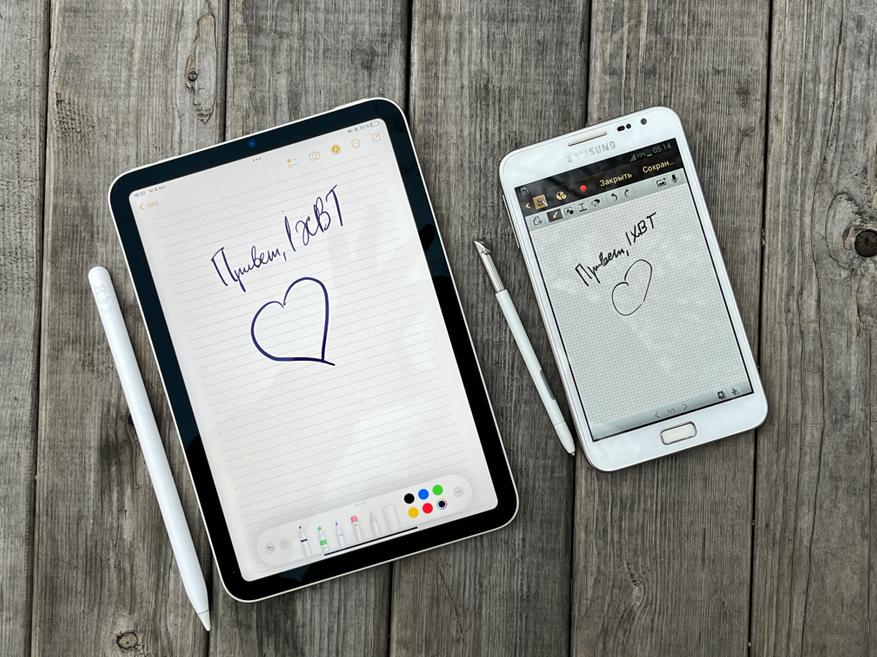
Когда-то, давным-давно, в 2007 году iPhone считался «лопатофоном» за счет огромного для того времени 3,5-дюймового экрана. В основном все смартфоны, или, как их тогда называли КПК, оснащались дисплеями с диагональю до 3 дюймов, но очень быстро 3,5 дюйма стали эталоном, от которого большинство компаний пытались уйти в сторону увеличения диагонали.
На это также повлиял выход iPad, вызвавший рост популярности планшетов и в этот период Samsung берет компактный планшетник Galaxy Tab 7 объединяет со своим флагманским смартфоном Galaxy S2 и выпускает Galaxy Note — огромный смартфон со стилусом.
Получается своеобразный смартфон-блокнот. Рынок принял его тепло, но с непониманием «зачем нужен такой большой смартфон?». Давайте разбираться, как это непонимание превратилось в стандарт.

Специально для статьи купил первый, оригинальный Galaxy Note и при распаковке пришел в восторг. В комплекте, помимо смартфона и мукулатуры лежит кабель питания, адаптер и даже наушники!
Неведомая по сегодняшним меркам роскошь. Сам девайс достался мне в отличном состоянии.
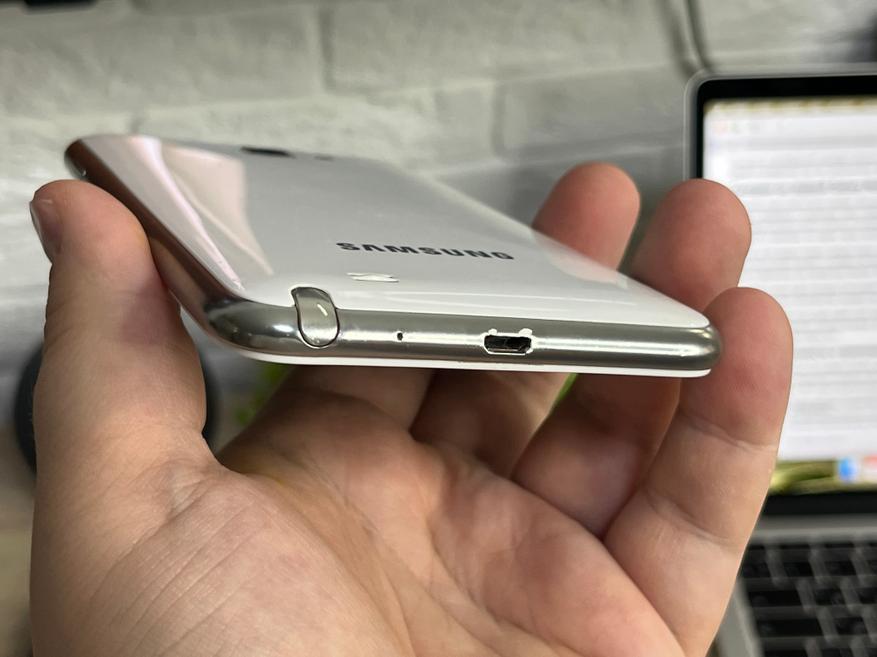
За 11 лет на рамке потертостей практически не появилось, на крышке видны следы от чехла, а я напомню, что корпус здесь полностью пластиковый.
Так что на эти нюансы можно закрыть глаза. Смартфон отличный! Беру в руку и кажется, что он выпущен ну край в 2014 году. На эти впечатления влияет дизайн и размеры. Он реально большой, экран 5,3 дюйма имеет нестандартное соотношение сторон 16:10, что шире по вертикали, чем привычные многим 16:9.

Что забавно, экран здесь меньше, чем в моем iPhone 13 mini (5,3 дюйма против 5,4 дюйма), но толстые рамки по всем сторонам забирают полезное пространство лицевой панели. Да, о подобной безрамочности в 2011-м только мечтали.
И раз уж заговорили про экран, здесь стоит SuperAMOLED матрица с разрешением 1280х800 пикселей, но за счет технологии PenTile, которая добавляет одному пикселю четыре субпикселя, изображение выглядит четко и гладко. То есть, пикселизации, такой, чтоб бросалась в глаза, здесь нет.

С производительностью, если можно сказать, здесь порядок с оговоркой на 2011 год. Изначально смартфон поставлялся с Android 2.3 Gingerbread, но предыдущий владелец обновил его до Android 4.1 Jelly Bean и работает оболочка дёргано. Анимации подтормаживают, для 2022 года такой расклад дел просто неприемлем, но если отмотать на 10 лет назад, то ок.
Актуальные на 2011 год игрушки, вроде N.O.V.A 3, Shadowgun, Asphalt 6 HD работают отлично. Про аркады типа Angry Birds и Temple Run говорить нечего, тут тем более все супер.
Насчет софта не все так однозначно, актуальные версии приложений не установить, а те, что еще можно, работают максимально отвратительно. А старые версии, времен начала 2010-х уже не работают. Поэтому с точки зрения рабочего инструмента первый Galaxy Note в 2022 году сложно рассматривать.
Хотя на 4PDA есть множество кастомных прошивок на основе Android 8. Тоже устаревшая версия, но с приложениями там было бы проще.
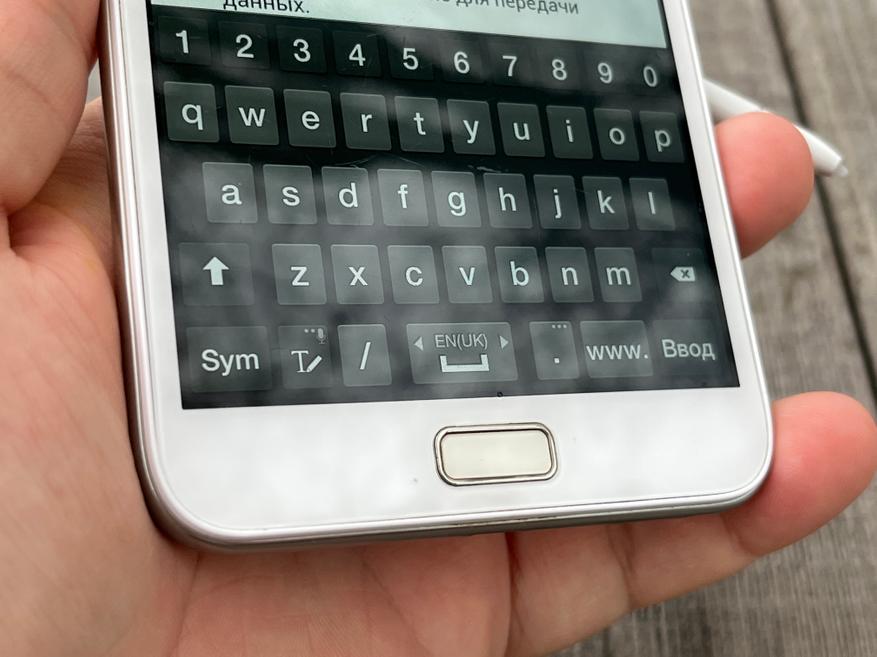
Еще быстро отмечу встроенную клавиатуру — она дурацкая. Если взять в сравнение клавиатуру в iPhone 4s, да что там, даже в самом первом iPhone, то там качество ввода на пять голов выше. Даже если вы будете набирать текст на iPhone на ходу, ошибок вы допустите минимум. А вот на Galaxy Note надо постараться, чтобы их не допустить.
Кстати, я уже рассказывал о том, как работает клавиатура iPhone, прочитать можете здесь.
Но давайте теперь поговорим о стилусе.
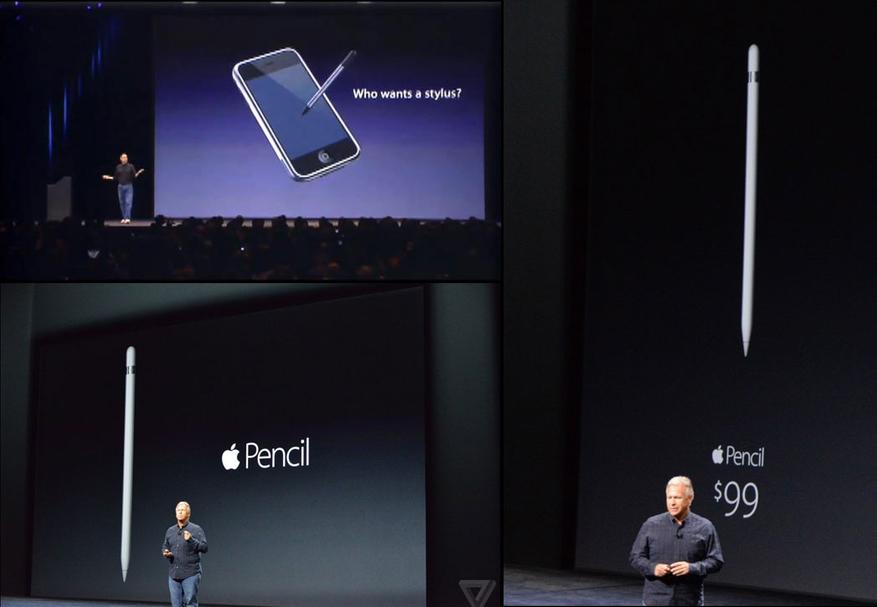
«Who wants a stylus» — знаменитая фраза Стива Джобса, прозвучавшая на презентации первого iPhone, которая перевернула мир смартфонов, или, как из тогда называли КПК. Если у КПК был сенсорный (резистивный) экран, то к нему обязательно полагался комплектный стилус, для которого была выделена специальная область на корпусе. Но в iPhone стилуса не было, Apple этот тренд взяли и прервали.
Дело в том, что для КПК стилус был необходимостью, ведь интерфейс Windows Mobile (как правило она была основной ОС) был максимально неадаптирован под управления пальцем. Некоторые элементы нужно было рассматривать буквально под лупой.
В этом смысле iPhone перевернул игру. Разработчики Apple сделали максимально удобный интерфейс, который оставил стилус в прошлом. Ну, до выхода Galaxy Note конечно же!
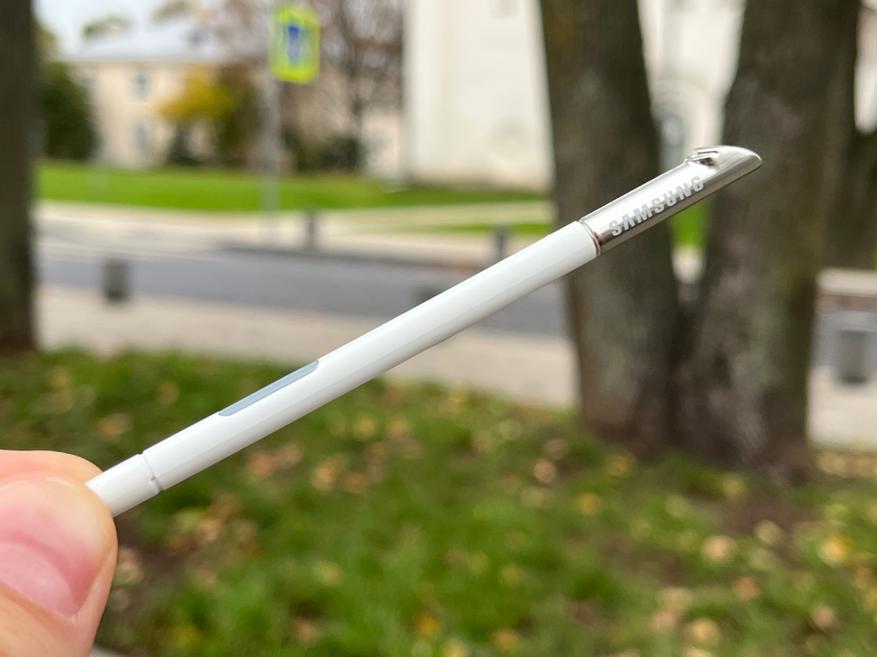
И тут стилус далеко не необходим, ведь экран огромный, а к интерфейсу TouchWiz подобных претензии быть не может.
Здесь стилус служит инструментом для определенной ниши потенциальных покупателей этого смартфона — гики, художники, бизнесмены и журналисты.
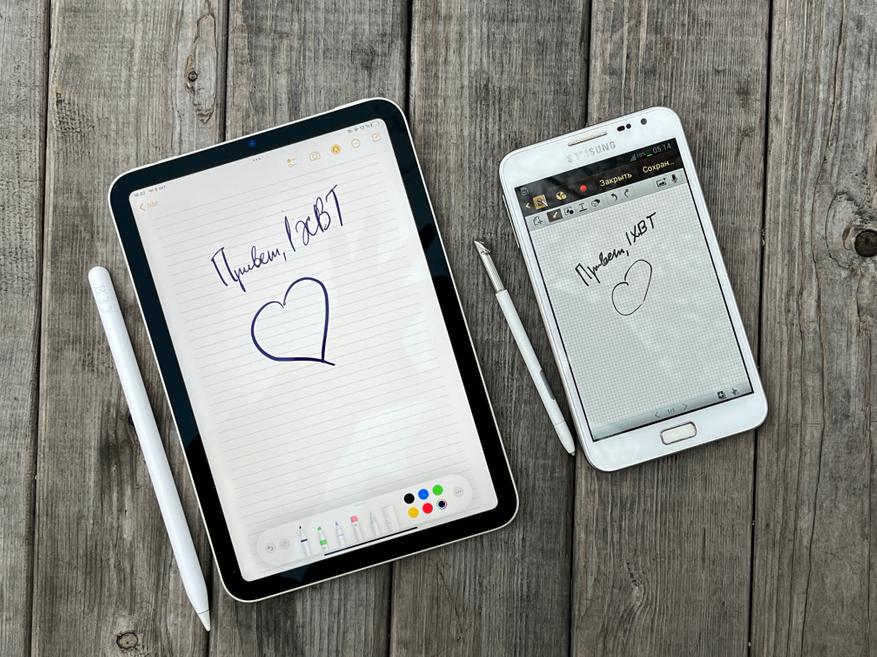
Я попробовал работу со стилусом и скажу так — конечно, это не уровень современных SPen и уж тем более не Apple Pencil, рисовать здесь нереально. Максимум, какие-то простые скетчи, не более, а вот заметки делать здорово.
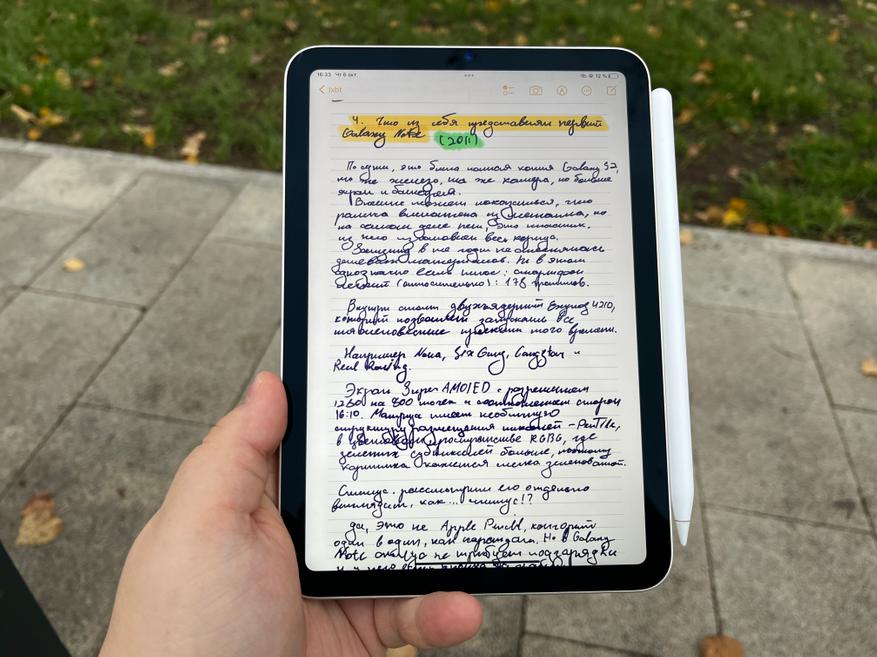
Если бы сейчас был 2011 год я бы без раздумий взял себе Galaxy Note, потому что я обожаю делать заметки и черновики текстов от руки. Даже эту статью изначально я накидывал на iPad mini с Apple Pencil. Но в 2011-м iPad с Pencil не было, а вот Galaxy Note был.
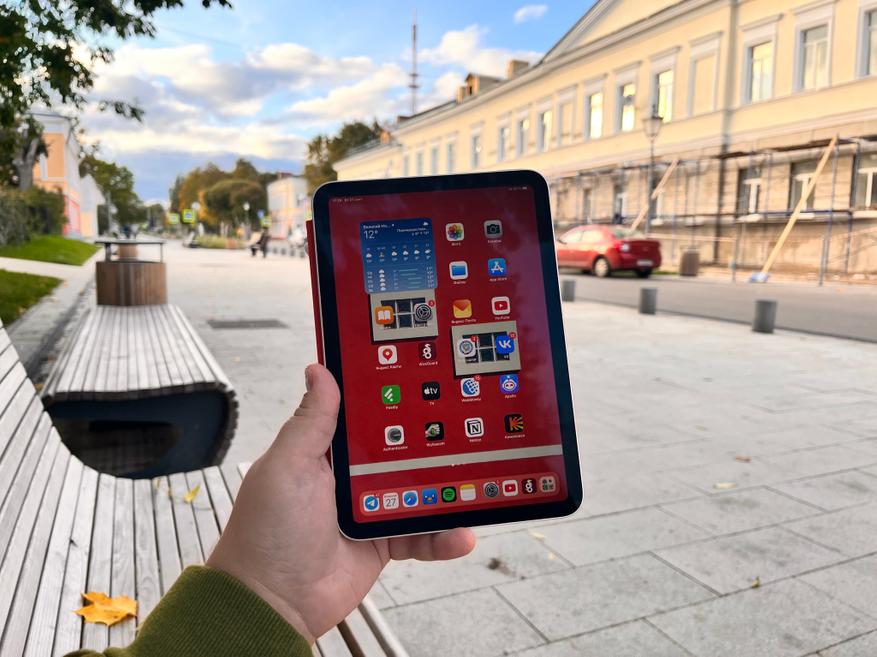
Получается очень классный карманный цифровой блокнот. Вот смотрю я на Galaxy Note и думаю, неужели только в 2011 году рынку пришла идея сделать большой смартфон?
И не просто большой, а функциональный! Чтоб конкурировал с компьютерами и ноутбуками! В середине 2000-х прямой конкуренции КПК и ПК, конечно, не было, первый дополнял второго, но двигаться куда-то было нужно.
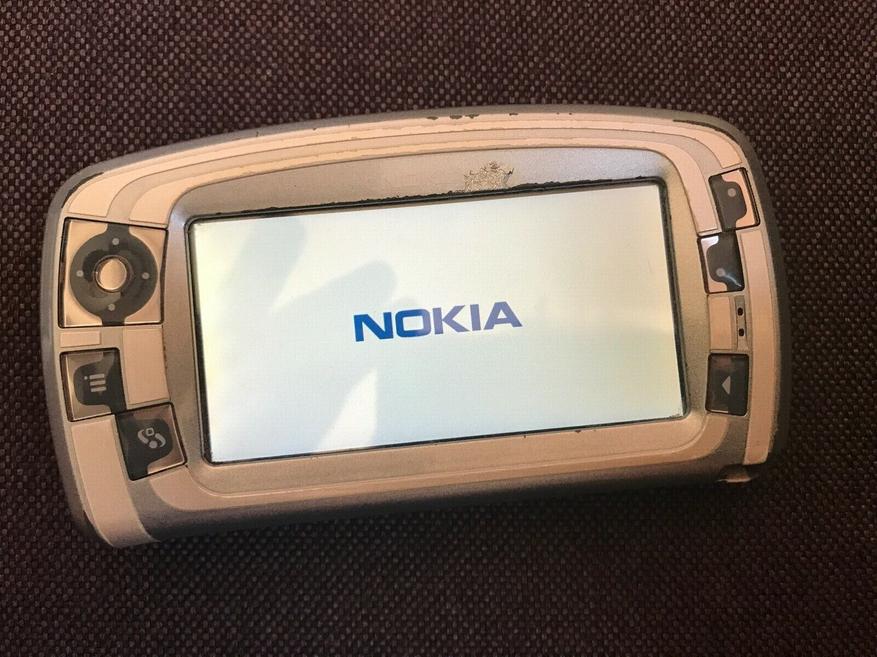
Идёт 2004 год, Nokia презентует свой карманный компьютер с сенсорным экраном Nokia 7710 на базе Symbian Series 90. Клавиатуры у девайса не было, только несколько функциональных клавиш для быстрого доступа в интернет, открытия контекстного меню, возврата на шаг назад, а также крестовина.
Экран по тем меркам огромный — 3,5 дюйма с соотношением сторон 2:1. Девайс позволял работать с электронной почтой, выходить в интернет и работать с офисом. Камера имела возможность записи видео в формате QCIF со скоростью 17 кадров/с в форматах MPEG4, H.263 и Real Video 8.
Революционно для своего времени, знаете ли. Но на этом движение к революционному мобильному будущему не закончилось.
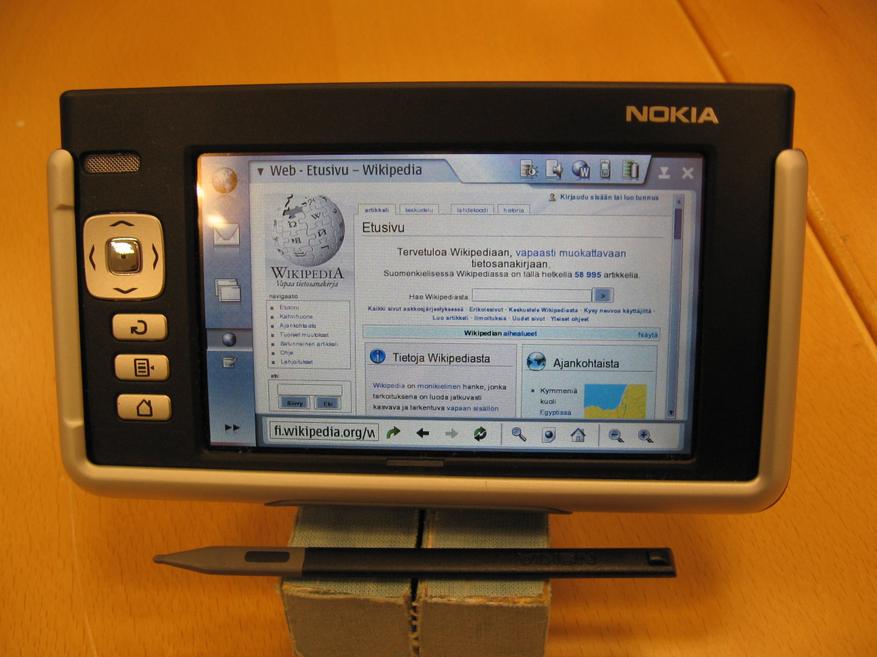
Через год в 2005-м, Nokia взяла и представила планшет, добавив пафосно «первый в мире».
Планшетом сегодня это сложно назвать, Nokia 770 был оснащен 4,1-дюймовым экраном с разрешением 800 на 480 пикселей. Внутри стоял ARM-процессор с частотой 252 МГц, а объём памяти составлял 128 мегабайт. Наличие Wi-Fi и Bluetooth в 2005 вообще было чем-то невероятным.
В отличие от своего предшественника, аппарат работал не на Symbian, а на Maemo, основанной на ядре Linux. Стоил аппарат 350 евро, что очень бюджетно, но из-за проблем с работой ОС и плохой автономности популярности Nokia 770 не снискал.
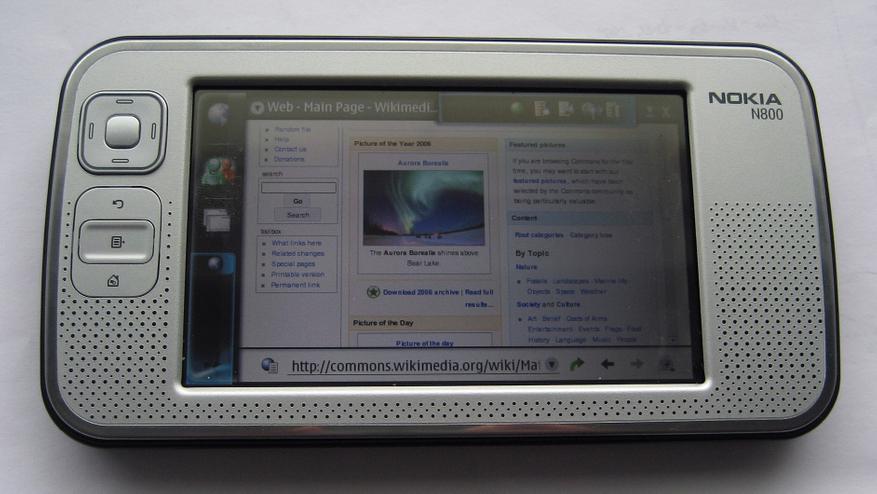
После провального 770, в январе 2007 года Nokia выпустила планшет N800, у него была версия с выдвижной клавиатурой (N810), доработанная прошивка и подобных болячек аппарат был лишен. Поэтому он был воспринят аудиторией уже лучше и Nokia решила не останавливаться, выпустив в 2009-м легендарный N900.
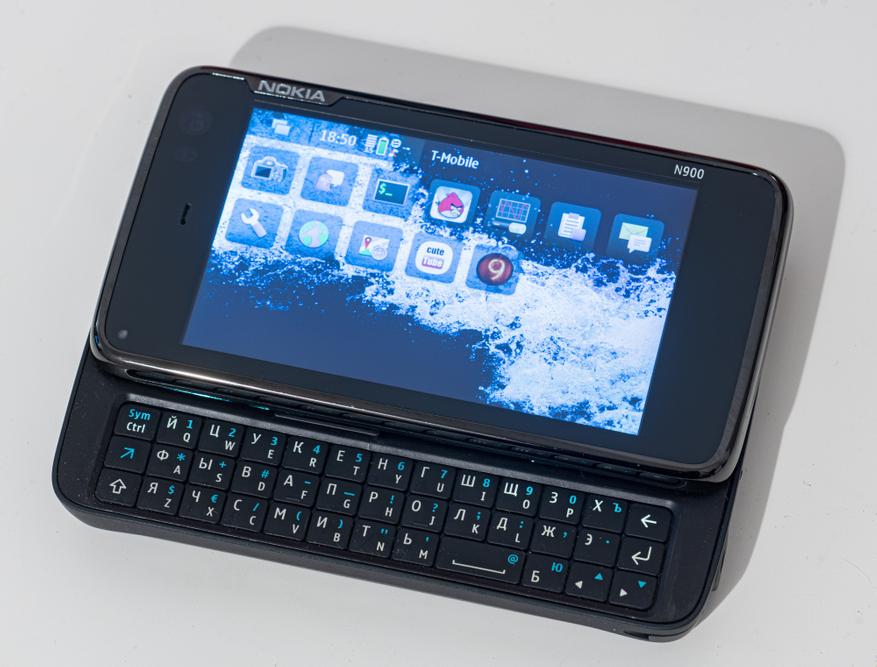
Несмотря на то что экран у N900 стал меньше: 3,5 дюйма против 4,1 дюйма у предшественников, он уже стал завершенным продуктом, хотя проблемы с автономностью остались. Владельцам приходилось носить с собой второй аккумулятор (к счастью, он здесь съёмный).
Популярность аппарата демонстрирует наличие кастомных прошивок. Можно при желании накатить Android, Ubuntu и даже MeeGo от потомка Nokia N9. Подробно про особенности N900 расскажу когда-нибудь в отдельном материале.
Аппарат, как и N97 рекламировался с подачи «первый мобильный компьютер» и это была чистая правда, потому что на N900 можно выполнять большинство повседневных задач, для которых раньше был нужен компьютер. Пользователям стало ясно, что большой экран — это круто и с ним можно делать какие-то сложные задачи на ходу. Такого раньше невозможно было представить.
Но одним из последних звонков к выходу большого смартфона для широкой аудитории стал Dell Streak 5.
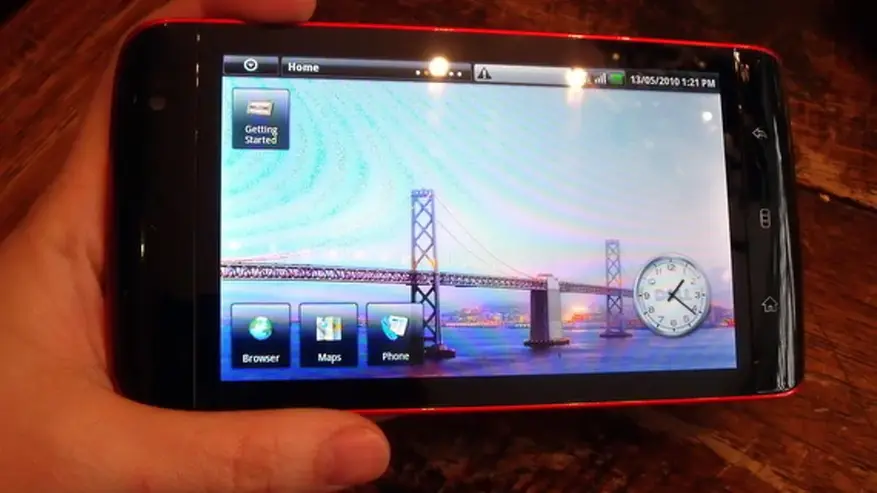
У него 5-дюймовый экран, и нет, это тоже не смартфон, а планшет. Так что Samsung была далеко не первой компанией экспериментировавшей с таким форм-фактором.
В Dell Streak 5 можно установить сим-карту, звонить, выходить в интернет где угодно. Получается классных компаньон к кнопочному телефону — идеальный iPod touch не иначе. Даже интерфейс рабочего стола здесь не смартфонный.
Лучше всего этот аппарат описывает один из отзывов на Яндекс.Маркете (текст отредактирован, исправлены грамматические ошибки, смысл сохранен):
«Пользуюсь 6 мес. Купил в КЕЙ за 16999, аппарат очень был нужен для работы: заполнения таблиц мониторинга в Экселе при посещении магазинов. Единственный 5-дюймовый полупланшет до недавнего времени с GSM, теперь есть Samsung Note по цене 3-х Dell Streak.Привыкание к 5 дюймам происходит в течении недели максимум, отвыкание невозможно. Все аппараты меньше кажутся игрушками. Корпус качественный, стекло хорошее, девайс падал на гранитный пол (в метро толкнули), поднял, думал все ,новый покупать надо, а нет… Все работает, только несколько мелких царапин на стекле.АКБ держит примерно 40 часов при минимальной яркости,3g,умеренном использовании (звонки 30-60 мин, чтение книг, немного интернета, приложения). Как-то сумбурно написал,но от души. Если еще получится что вспомнить,напищу :)».
Отзыв на Яндекс.Маркет
Ключевое «отвыкнуть от 5 дюймов невозможно» описывает дальнейшее развитие мобильного рынка.
Но в истории фаблетов не все было так легко и просто.
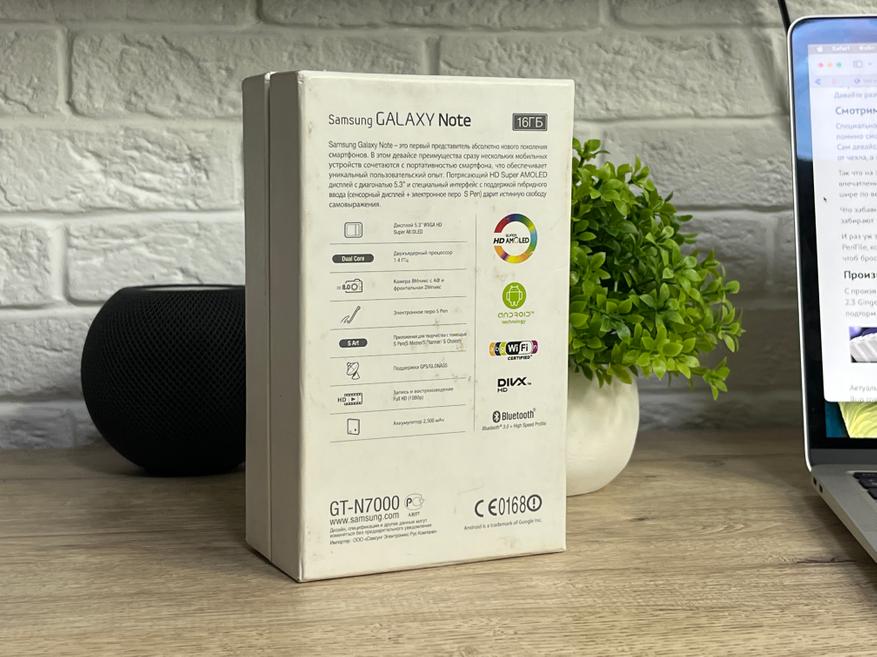
Выход Samsung Galaxy Note у многих вызвал непонимание. Обзорщики и ИТ-журналисты только и сравнивали девайс с планшетом, подшучивали над его размерами и тем, как выглядит владелец Galaxy Note говорящий по нему. Но конкуренты идею подхватили.
В 2012 году, буквально через полгода после выхода Galaxy Note в 2011-м, LG выпускает на рынок свой первый фаблет LG Optimus Vu. Огромный смартфон с 5-дюймовым экраном, имеющим соотношением сторон 4:3 и чипом Nvidia Tegra, который тогда тянул все топовые игры.

Стилус у LG Optimus Vu тоже есть, но в отличие от Galaxy Note, это не цифровое перо, а простая «тыкалка» с резиновым наконечником, которую к смартфону даже нельзя прикрепить, места в корпусе попросту нет.
Да и в целом чего-то особенного у LG Optimus Vu, что могло бы выделить его на рынке, не было. Тем не менее LG выпустила еще два смартфона в этой линейке — Vu 2 и Vu 3, после чего забыла о бренде.

Другие компании, например, Sony и HTC к гонке диагоналей подключились в 2013 году. Тогда никто особо не рисковал применять дисплеи 5,5 и более дюймов в основных линейках. Но и пародировать Galaxy Note не хотелось, поэтому у Sony был Xperia Z Ultra с 6,4 дюймовым экраном. Такая диагональ даже по сегодняшним меркам будет «приличной». А в 2013 это был вовсе вынос мозга.
HTC тоже экспериментировала, результатом этого стал HTC One Max с 5,9-дюймовым экраном. Но в целом рост диагоналей у других устройств был плавным. В 2014-м оптимальным уже считалось 4,5-5 дюймов, правда была одна компания, которая ну никак не хотела вливаться в тренд. Конечно я про Apple.
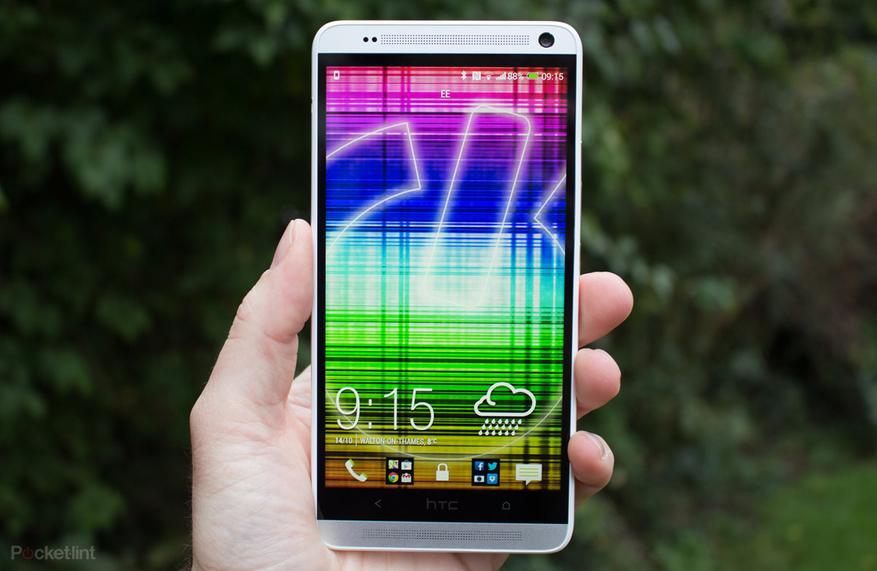
В 2007 вышел первый iPhone с экраном 3,5 дюйма и для компании это был эталон, потому что до каждой части экрана можно дотянуться одним пальцем. Действительно, очень удобно, даже сегодня, когда я беру с полки iPhone 4s (последний iPhone с такой диагональю) удивляюсь, как аппарат идеально помещается на ладони.
Apple тоже так думали, поэтому не спешили с подобными экспериментами. Да, в iPhone 5 (2012 г.) диагональ увеличили по высоте до 4 дюймов, но компактность осталась на прежнем уровне, а вместо собственного фаблета выпустили iPad mini.

Рыночек, как говорится, порешал и в 2014 мы увидели iPhone 6 и 6 Plus с дисплеями 4,7 и 5,5 дюйма соответственно. У них не было стилуса, просто большие смартфоны, которые были проданы общим тиражом около 220 миллионов штук. Это. Очень. Много.
Всему рынку стало отчетливо ясно, чего хотят пользователи, — они хотят большой смартфон. И буквально за 3-4 года 5 дюймов превратились из диковинки в стандарт. Правда, за счет уменьшения рамок современные смартфоны остались довольно удобными. Так что 6,7-дюймовые iPhone Pro Max берут даже хрупкие девушки.
Подумать о таком в 2011-м было невозможно. Galaxy Note казался смартфоном с планеты гигантов, устройством для гиков, но в итоге оказался народным смартфоном, не опередившим, а определившим десятилетие.
Давайте теперь рассмотрим развитие линейки Galaxy Note от поколения к поколению. Мало кто знает, но именно с Galaxy Note начался тренд на смартфоны с изогнутыми экранами.
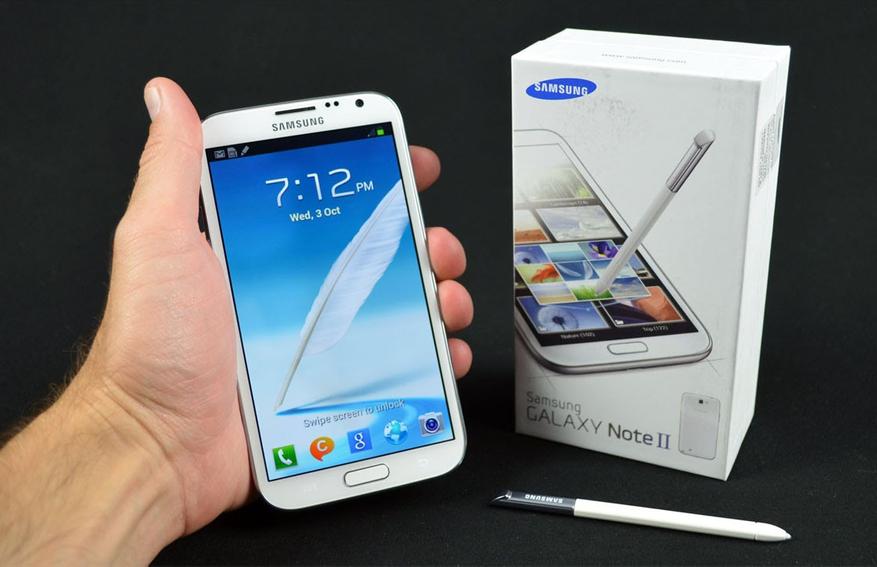
Уже через год, в 2012-м, Samsung презентует Galaxy Note второго поколения. Экран ещё больше — 5,5 дюйма вместо 5,3 с соотношением сторон 16:9. Новая оболочка Touchwiz получила новое приложения для заметок S Note и фишку с мультиоконностью.
Например, вы можете открыть календарь открыть календарь, пока работаете в браузере. Хотите, можете даже два приложения в формате Split View открыть! И все это уже было на смартфоне в 2012 году. Абсолютный восторг.
Ещё фишки:
- S Pen теперь может определять до 1024 уровней давления
- Опция Air View позволила мгновенно просматривать контент, простым наведением пера.
На этом развитие не закончилось.
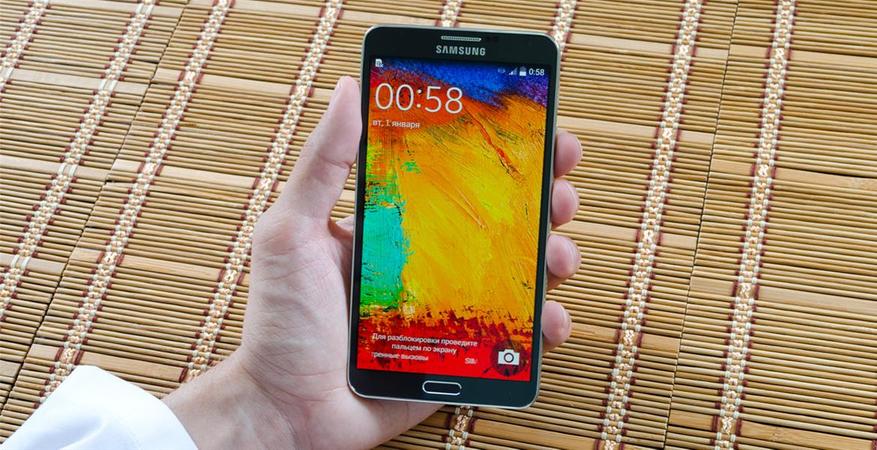
Смартфон обрел маскулинность. Вместо глянцевого пластика, пластик, стилизованный под кожу. Разрешение дисплея выросло с 1280х800 до 1920х1080 (FullHD). Камера научилась снимать видео в 4К.
В интерфейсе S Pen появились быстрые команды. Теперь стало возможно делать быстрые заметки в любом приложении, или молниеносно перейти к поиску по файлам и выбору избранных приложений.

Базой для Galaxy Note 4 выступил Samsung Galaxy S5, от него в смартфон пришли сканер отпечатков пальцев и пульсоксиметр на задней панели.
Каркас, наконец, сделали из полноценного алюминия, от чего смартфон стал выглядеть по-настоящему премиально, ощущается также.
Сканер отпечатков пальцев в кнопке Home работал необычно. Если в современных смартфонах палец надо просто приложить, то в Galaxy Note 4 его нужно приложить к кнопке и сделать свайп по ней сверху вниз.
Но.это была отнюдь не единственная новинка Samsung в линейке Galaxy Note в этом году.

На дворе 2013 год, на конференции CES Samsung демонстрирует прототип смартфона Youm с изогнутым дисплеем OLED. Что примечательно, изгиб есть только на правой грани.
Через год, в 2014-м, этот прототип превращается в Galaxy Note Edge, первый смартфон с изогнутым экраном. Причем Samsung интересно обыграла эту область, разместив на ней ярлыки приложений и функциональные расширения, например, прогноз погоды.
При выключенном экране, на изгибе отображалось время, заряд и дата. А если положить Galaxy Note Edge во время зарядки экраном вниз, изгиб будет мерцать разными цветами, сигнализируя об уровне заряда и поступаемся уведомлениях.
Samsung даже выпустила API для разработчиков, чтобы те могли создавать свои расширения для панели Edge.
Что интересно, через, в Galaxy Note 5 от панели Edge Samsung отказалась, оставив её для флагмана Samsung Galaxy S6 Edge.
Этим нововведением Samsung подарила всему мобильному рынку тренд, которому компании следуют до сих пор.
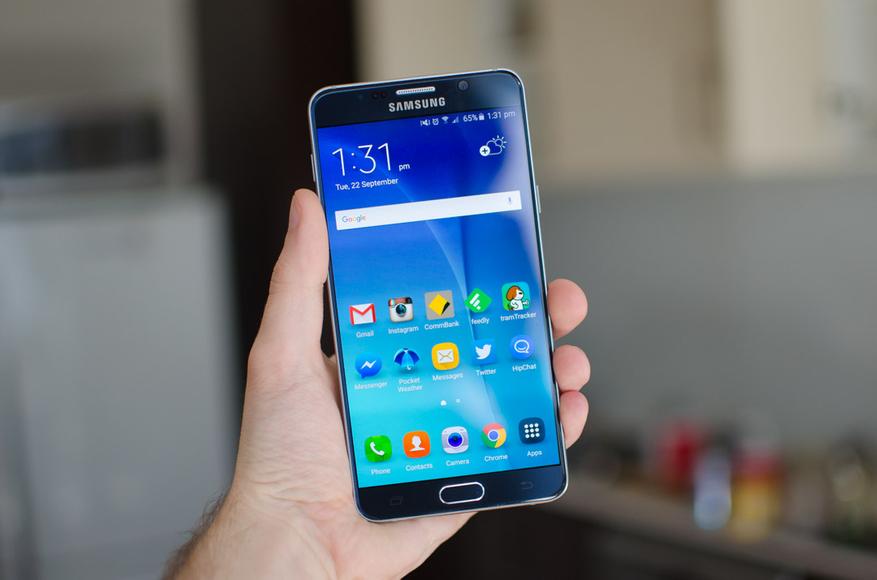
Galaxy Note 5 уже сильно отличался от своих предшественников. На место пластика пришло стекло и алюминий. Настоящий премиум.
Стилус теперь особым образом прятался внутрь — чтобы его вынуть нужно нажать на него и механизм вытягивал его наружу. Но без проблем не обошлось.
Некоторые пользователи случайно (а кто-то специально) вставляли его обратной стороной. В таком случае S Pen внутри застревал и вынуть его было не так просто. Недоработку прозвали Pengate.
Есть определённый способ, которым можно достать перо, но большинство его варварски выковыривали швейными иглами, повреждая встроенный датчик, определявший наличие S Pen внутри смартфона.
Но это еще цветочки. Ягодки были в Galaxy Note 7.
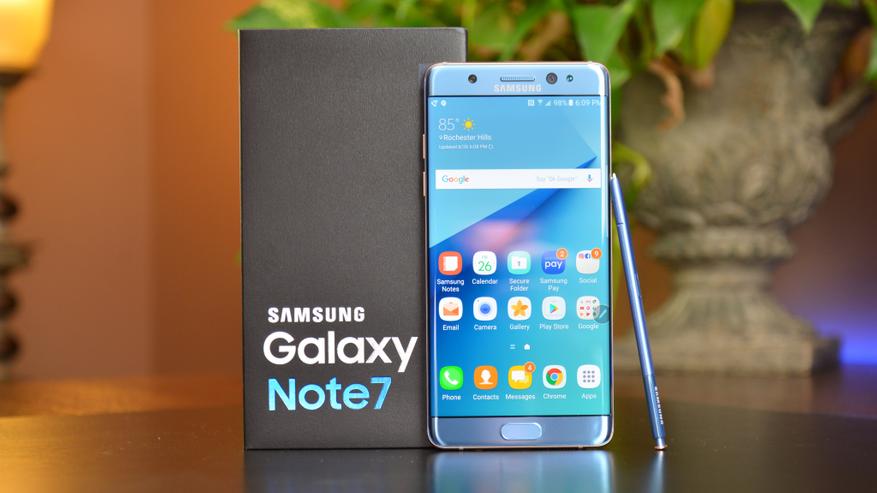
А где же Galaxy Note 6? А нигде. Samsung пропустила это число и от 5 сразу перешла к 7. Осмелюсь предположить, что этот смартфон знают даже те, кто далек от увлечения мобильным рынком и отнюдь не из-за того, какой он классный. Потому что это была по-настоящему горячая новинка.
Шутки-шутками, а владельцам было не до смеха.
Аппарат поступил в продажу 2 августа года и уже 6 октября был снят с продажи, а поставки прекращены. За это время Samsung продала миллион селдьмых Galaxy Note и порядка 100 из них взорвались или загорелись на зарядке у своих владельцев.
Из-за этого авиакомпании даже запретили проносить на борт самолетов Galaxy Note 7. Сама Samsung после поднявшегося скандала призвала пользователей Note 7 немедленно прекратить использования смартфона.
Официальная причина произошедшего: инженерная ошибка, допущенная при проектировании батареи.
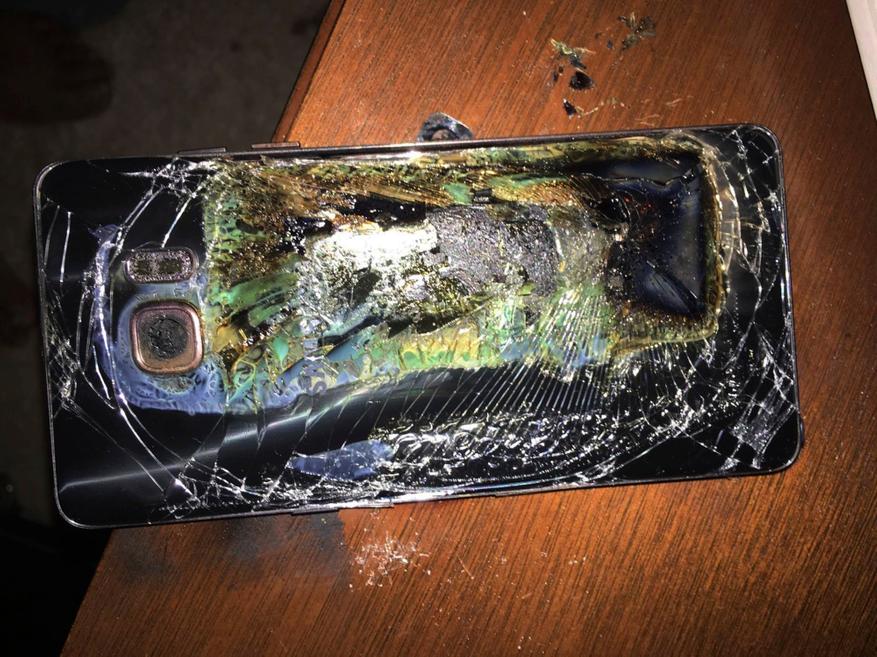
Фактически дело в высокой ёмкости батареи и быстрой зарядке. Из-за проблем с возгоранием Galaxy Note 7 капитализация Samsung обвалилась на миллиарды долларов. Спустя время все пришло в порядок, но смартфон до широких масс так и не дошел. При этом, Galaxy Note 7 был первым смартфоном Samsung с Type-C, супербыстрой (лол) зарядкой и закругленным по сторонам экраном.
Через год Samsung выпускает Galaxy Note 7 Fan Edition для «ценителей» с уменьшенной батареей, но популярности так и не снискал. Наверное, из-за своей «сгоревшей» репутации.
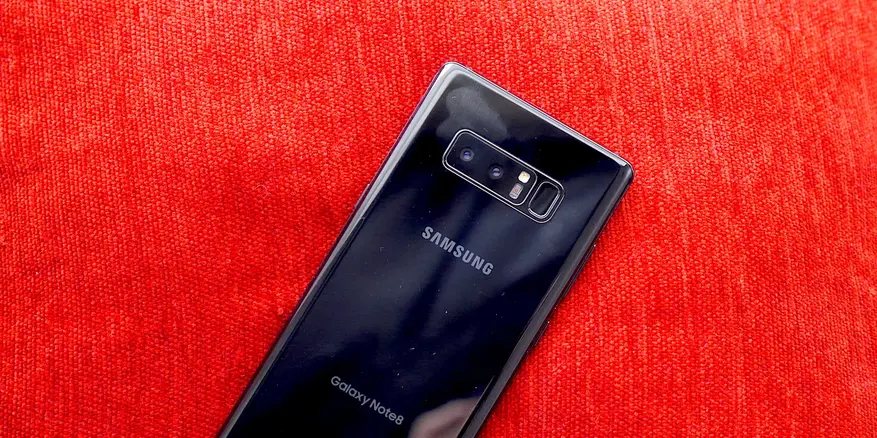
В 2017-м выходит Galaxy Note 8. Помимо загнутого экрана, углы дисплеи получили закругления, камеры стали лучше снимать, железо покруче. В таком же плане шло развитие всех последующих представителей Galaxy Note.
Всего вышло десять поколений устройств (без учета каких-то модификаций) и в 2022 году Samsung отказалась от бренда Galaxy Note, перенеся основные фишки (в том числе S Pen) во флагманскую линейку Galaxy S Ultra. Трогал недавно Galaxy S22 Ultra и хочу сказать, что подставив в название Note, это был бы смартфон той самой легендарной линейки. Разницы никакой.
Так к чему это я? А к тому, что наследие Galaxy Note живет в каждом современном смартфоне и этот девайс произвел не меньшую революцию на рынке мобильных устройств, чем iPhone. Может, даже и большую.
Существует несколько знаковых линеек смартфонов, в их числе — серия Samsung Galaxy Note. С этой линейкой Samsung смело вошла в сегмент, где прежде было мало смартфонов.
Благодаря передовым технологиям, высокому качеству и акценту на дизайн, серия Samsung Galaxy Note всегда шла параллельно другой флагманской линейке — Galaxy S. В этой серии используется такое нишевое решение, как стилус, который постоянно получает новые функции. И после запуска Samsung Galaxy Note 20 и Note 20 Ultra пришло время кратко рассмотреть все достоинства и недостатки этой серии смартфонов — от оригинального Galaxy Note, который оказал огромное влияние на индустрию Android-смартфонов, до недолговечного Galaxy Note 7 и последних Galaxy Note 10 и Galaxy Note 20.
Инфографика: ключевые нововведения всех смартфонов серии
Galaxy Note (2011): смелое решение
2011 год стал знаковым для индустрии смартфонов. Nokia перешла с Symbian на Windows Phone, Android Froyo был на пике популярности, а Dell Streak с его 5-дюймовым дисплеем выглядел таким большим, что казалось, будто он не имеет права на существование.
Ещё одним знаковым событием того года стал запуск Samsung Galaxy Note. Обладая огромным по тем временам 5,3-дюймовым дисплеем, он считался «бегемотом», и в отзывах и обзорах его нередко называли нелепым и не особо привлекательным для масс. Неоднозначно восприняла публика и возвращение стилуса, который считался устаревшим предметом времён первых ёмкостных дисплеев.
Но в итоге оригинальный Samsung Galaxy Note стал одним из самых влиятельных смартфонов и задал планку Android-флагманам. Фактически, он узаконил категорию флагманов благодаря своим топовым характеристикам и чувствительному к давлению стилусу. Разойдясь 10-миллионным тиражом, смартфон превзошёл все ожидания и сыграл решающую роль в изменении широко распространённого тогда мнения о том, что пользователям не нужны большие дисплеи.
Факты о Samsung Galaxy Note:
- Оригинальный Galaxy Note дебютировал с пером, способным распознать 256 уровней нажатия.
- Смартфон поставлялся с Android 2.3 на борту и получал обновления вплоть до Android 4.1.
- В то время как в Северной Америке продавалась модель на базе Qualcomm Snapdragon S3, для большинства других регионов смартфон поставлялся в версии на Exynos 4210.
- Его 5,3-дюймовый HD-дисплей был одним из самых больших для своего времени.
Galaxy Note 2 (2012): усовершенствованная версия
В то время как оригинальный Samsung Galaxy Note подтвердил существование рыночного спроса на смартфон с большим дисплеем и стилусом, Galaxy Note 2, выпущенный в 2012 году, сосредоточился на улучшении впечатлений. Усовершенствованная модель понравилась аудитории и Samsung удалось продать более 3 миллионов единиц Galaxy Note 2 в течение двух месяцев после его запуска.
Более округлый корпус сделал смартфон эргономичнее. Samsung уменьшил Galaxy Note 2 по многим фронтам, включая рамки на лицевой панели, что позволило уместить ещё более крупный 5,5-дюймовый дисплей, не делая смартфон заметно больше.
А стилус S Pen получил новые возможности. Например, функция Air View позволяла использовать его в качестве указателя. Также с его помощью можно было увеличивать текст в электронных письмах или контекстных раскрывающихся меню в календаре.
Факты о Samsung Galaxy Note 2:
- В Galaxy Note 2 появилась функция разделения экрана для одновременного отображения двух приложений.
- Samsung повысила чувствительность S Pen к давлению до 1024 уровней для большей точности.
- В смартфоне также дебютировала функция Air View, позволяющая моментально просматривать контент наведением пера.
Galaxy Note 3 (2013): лучший для бизнеса
Поскольку широкая публика осталась довольна большим экраном, Samsung захотела привлечь к серии Galaxy Note внимание другого сегмента пользователей — корпоративных и бизнес-клиентов.
Выпуская Galaxy Note 3, Samsung улучшила дизайн, чтобы сделать его более привлекательным для бизнес-пользователей. Конечно, и аппаратное обеспечение во главе с большим 5,7-дюймовым дисплеем было на высшем уровне. Он стал первым смартфоном в линейке с экраном Full HD. Фактически, Samsung упаковала Galaxy Note 3 до краёв такими топовыми фишками, как съёмка видео в 4K, стекло Gorilla Glass 3, высококачественный ЦАП и множество новых сенсоров, включая датчики влажности и температуры.
Что же касается дизайна, то Samsung объединила каркас, стилизованный под полированный алюминий, с задней крышкой из искусственной кожи, что добавило определённой изысканности для деловых людей. Солидная внешность и новые функции придали смартфону ещё большую привлекательность.
Samsung удалось продать более 10 миллионов единиц Galaxy Note 3 за первые два месяца, что сделало его одним из самых продаваемых смартфонов премиум-класса в 2013 году.
Стилус S Pen также серьёзно обновился и получил новые функции, включая Air Command. Эта фишка работала как традиционный щелчок правой кнопкой мыши, чтобы получить доступ к наиболее часто используемым функциям. Многие из этих фишек сегодня могут показаться мелочью, но стремление Samsung использовать возможности стилуса по максимуму нельзя игнорировать.
Факты о Samsung Galaxy Note 3:
- Дизайн Samsung Galaxy представлял собой смесь из пластика «под металл» и искусственной кожи.
- Его увеличенный дисплей поддерживал разрешение 1080p.
- Samsung Galaxy Note 3 стал первым смартфоном с 3 ГБ оперативной памяти.
Galaxy Note 4 (2014): реалистичный подход к решению проблем
К 2014 году серия Samsung Galaxy Note уже была той силой, с которой нужно было считаться. Большой размер экрана, удобные функции S Pen и высочайшая производительность сделали его фаворитом для многих пользователей.
Samsung вернулась к стандартной пластиковой задней панели, а чтобы добавить внешнему виду премиальности, использовала алюминиевую рамку. Кроме того, разрешение экрана было увеличено до Quad HD, а сам дисплей был покрыт стеклом Corning Gorilla Glass 4, что сделало его одним из лучших в то время.
Другие новые функции включали в себя сканер отпечатков пальцев в кнопке «Домой» и улучшенную камеру на 16 мегапикселей. Samsung даже добавила оптическую стабилизацию изображения — функцию, которая сегодня считается само собой разумеющейся.
С Galaxy Note 4 компания сосредоточила внимание на расширении экосистемы, а не только на аппаратном обеспечении. Смартфон с пульсометром и пульсоксиметром на задней панели подчеркнул, что Samsung уделяет внимание технологиям в области фитнеса и здоровья.
Чувствительность стилуса S Pen увеличилась вдвое до 2048 уровней, что сделало его более удобным для рисования.
Факты о Samsung Galaxy Note 4:
- В Samsung Galaxy Note 4 пластиковый каркас «под металл» был заменён рамкой из алюминия.
- Стилус опять был модернизирован и получил возможность распознавать до 2048 уровней давления.
- В смартфоне помимо пульсометра и датчика определения уровня насыщенности крови кислородом также был установлен датчик для измерения ультрафиолетового излучения.
Galaxy Note Edge (2014): время экспериментов
После того, как серия Galaxy Note прочно обосновалась на рынке и стала частью флагманской линейки Samsung, компания решила, что пришло время немного поэкспериментировать, и в результате на свет появился Galaxy Note Edge.
Хотя его спецификации были идентичны Galaxy Note 4, Edge-модель сделала смелый для своего времени шаг вперёд. Это была первая громкая попытка добавить удобный изогнутый дисплей в обычный смартфон. На изогнутом крае была расположена боковая панель, которую предлагалось использовать для отображения различных данных и ярлыков приложений. Samsung также предоставила разработчикам доступ к API для создания приложений для изогнутого экрана. А изящности изогнутому дисплею добавляла функция отображения времени на боковой панели даже при выключенном дисплее.
Факты о Samsung Galaxy Note Edge:
- Смартфон впервые дебютировал как концептуальный аппарат под названием Youm на выставке CES 2013.
- Galaxy Note Edge был одним из первых смартфонов с изогнутым дисплеем.
Galaxy Note5 (2015): швейцарский армейский нож в мире смартфонов
Выпущенный в 2015 году в рамках ежегодного цикла обновлений Samsung Galaxy Note5 получил заметные улучшения по всем фронтам. Конечно, процессор стал быстрее, но главное — серьёзно изменились дизайн и отделка.
Galaxy Note 5 был выполнен в корпусе из стекла и металла с упором на эргономику и удобство использования. Но, к сожалению, в погоне за комфортом он лишился нескольких ценных функций. Начнём с того, что у Samsung Galaxy Note5 не было съёмного аккумулятора. Более того, в смартфоне отсутствовал и слот для microSD-карты. Также из-за особенностей конструкции пружинный блок ломался, если стилус S Pen был неправильно вставлен в слот.
Но несмотря на все эти проблемы, Galaxy Note5 побил рекорд продаж в этой серии и стал одним из самых популярных смартфонов того года.
Факты о Samsung Galaxy Note5:
- Galaxy Note 5 вышел со стеклянной задней панелью и подпружиненным стилусом. Если вставить стилус наоборот, то он заклинивает, что может привести к поломке.
- Galaxy Note 5 также положил начало использованию в серии Galaxy Note встроенных аккумуляторов.
Galaxy Note7 (2016): сбои и воспламенения
Samsung пропустила Galaxy Note 6 и вместо «шестёрки» выпустила печально известный Galaxy Note7. У него было много интересного. Это был первый смартфон в серии Galaxy Note, оснащённый разъёмом USB Type-C. Он также вернул поддержку microSD-карт, которой был лишён Galaxy Note5, и получил защиту от пыли и влаги с рейтингом IP68.
Стилус S Pen получил совершенно новые возможности, включая функцию перевода, экранную лупу и возможность записи GIF. Устройство объединило новомодный сканер радужной оболочки глаза с Samsung Pass, что позволило использовать его для безопасных платежей.
Смартфон стал серьёзным обновлением серии Galaxy Note, а потому вызвал огромный восторг. Предварительные заказы на Galaxy Note7 на внутреннем рынке в Южной Корее превзошли все ожидания. Спрос на новый смартфон был высок и в других странах.
Однако вскоре после запуска в августе 2016 года от многих владельцев Galaxy Note7 начали поступать сообщения о том, что смартфон перегревается, а в некоторых случаях даже взрывается. Сначала Samsung отозвала первую якобы бракованную партию смартфонов и заменила их на новые, но и смартфоны из новой партии были склонны к возгоранию. В итоге Samsung отключила все Galaxy Note 7 спустя меньше чем два месяца после запуска.
- В тему: Обзор фаблета Samsung Galaxy Note7
Как феникс из пепла, Galaxy Note7 возродился через год после своей кончины, в середине 2017 года. Восстановленная модель с уменьшенным аккумулятором продавалась в некоторых странах Азии под названием Galaxy Note Fan Edition. Она первой в линейке получила встроенный голосовой помощник Bixby.
Факты о Samsung Galaxy Note7:
- Смартфон получил инфракрасную систему распознавания радужной оболочки глаз для безопасной разблокировки.
- Samsung отправляла покупателям Galaxy Note7 огнестойкие коробки для безопасного возврата смартфона. Позже вышло обновление программного обеспечения, которое полностью отключило Galaxy Note7.
- Через год Galaxy Note7 вернулся как Galaxy Note7 Fan Edition с уменьшенной батареей и новыми функциями безопасности.
Galaxy Note8 (2017): возрождение серии
После провала Galaxy Note 7 компании Samsung вновь пришлось проявить себя. Она рисковала, запуская Galaxy Note8, но постаралась избежать потенциальных проблем, пойдя на ряд компромиссов, например, уменьшив размер батареи.
Обновив характеристики смартфона, Samsung также реализовала в Galaxy Note8 технологию Dex. Эта функция позволяла использовать Galaxy Note8 в качестве компьютера, подключив его к монитору и клавиатуре. Также Galaxy Note8 стал первым представителем серии Galaxy Note, оснащённым двойной камерой — основной на 12 Мп и дополнительной на 12 Мп с телеобъективом.
- В тему: Обзор Samsung Galaxy Note8
Благодаря всесторонним улучшениям, Samsung удалось продать рекордное количество Galaxy Note8 — более 270 тысяч единиц только за первые несколько дней после старта продаж.
Факты о Samsung Galaxy Note8:
- Galaxy Note8 стал первым смартфоном в серии, оснащённым системой с двумя объективами.
- У смартфона была специальная клавиша для вызова виртуального помощника Samsung Bixby.
- Обновлённое приложение камеры позволило регулировать интенсивность размытия фона как до, так и после съёмки.
Galaxy Note9 (2018): отсутствие инноваций
Galaxy Note9 представлял собой небольшое обновление во многих отношениях, но это не значит, что ему не хватало возможностей. Как и следовало ожидать, он имел лучший в линейке чипсет и был первым смартфоном Samsung, получившим до 8 ГБ оперативной и до 512 ГБ встроенной памяти.
В Galaxy Note9 компания сосредоточилась на усовершенствовании имеющихся функций. Так, технология Dex в новом смартфоне не требовала обязательного использования док-станции. Также компания добавила систему охлаждения с тепловыми трубками с использованием углеродного волокна для лучшего отведения тепла во время игр.
Однако самые большие изменения коснулись S Pen. Благодаря расширенным возможностям Bluetooth и встроенной батарее стилус можно было использовать, например, в качестве кликера во время демонстрации презентаций.
Тем не менее, замедление темпов внедрения инноваций отразилось на продажах. Samsung поставила в общей сложности около 9,6 млн Galaxy Note9, то есть меньше, чем было продано Galaxy Note8. Это говорило о снижении спроса на премиальные смартфоны Samsung.
Факты о Samsung Galaxy Note9:
- S Pen получил аккумулятор, который заряжается через слот в нижней части смартфона.
- 40 секунд зарядки хватало на 30 минут работы стилуса.
- Galaxy Note 9 стал последним смартфоном в серии Note с отдельным разъёмом для наушников.
Galaxy Note10 (2019): один смартфон, два размера
Поскольку смартфоны становились всё больше, настало время для решительных действий. Samsung Galaxy Note10 вышел не в одной, а в двух версиях. Такое решение позволило Samsung ориентироваться сразу на несколько ценовых сегментов на рынке, что было крайне важно после откровенно слабых продаж Galaxy Note 9.
Старшая модель была оснащена массивным 6,8-дюймовым AMOLED-дисплеем с такими функциями, как HDR10+ для более точной цветопередачи. Смартфон был немного выше, а его экран обладал соотношением сторон 19:9. Между тем, младшая модель была по-прежнему оборудована 6,3-дюймовым дисплеем с разрешением Full HD, но при этом получила уменьшенные по сравнению с предшественником габариты.
За исключением экранов, у смартфонов было много общего, включая процессор и камеры. Обе модели оснащались новой 16-мегапиксельной сверхширокоугольной камерой, которая дополняла основной модуль и сенсор с телеобъективом.
Как и прежде, S Pen тоже получил обновление и теперь с его помощью можно управлять смартфоном на расстоянии.
Помимо размеров дисплея смартфоны также отличались друг от друга батареями. В Galaxy Note10+ компания Samsung установила аккумулятор ёмкостью 4 300 мАч, тогда как обычная модель получила батарею поменьше — на 3 500 мАч. Старшая модель поддерживала зарядку мощностью до 45 Вт, а мощность зарядки обычной модели была снижена до 25 Вт. И, наконец, смартфоны Galaxy Note10 стали первыми в серии без 3,5-миллиметрового разъёма для наушников.
Серия Samsung Galaxy Note10 побила рекорды продаж в Южной Корее. Только за первые 25 дней было продано миллион смартфонов. Уменьшение размеров корпуса помогло привлечь ещё одну группу пользователей — Samsung объявила о росте числа женщин среди покупателей серии Galaxy Note.
Факты о Samsung Galaxy Note10:
- В смартфонах впервые появился дисплей Infinity-O с вырезом для селфи-камеры.
- В Samsung Galaxy Note 10 объединили кнопку питания и кнопку для Bixby.
- Samsung представила урезанную версию под названием Galaxy Note 10 Lite с уменьшенной вычислительной мощностью и более скромными характеристиками дисплея, но с быстрой зарядкой, стилусом и разъёмом для наушников.
Galaxy Note20 (2020): смелый взгляд
Вот мы и подошли к последнему и лучшему из достижений Samsung. Galaxy Note20 поднимает серию на ступеньку выше. Да, дизайн двух новых моделей имеет сходство с Galaxy Note 10, но они во многих отношениях стали значительным обновлением.
Начнём с Galaxy Note20 Ultra. Большой корпус из алюминия получил новый великолепный бронзовый оттенок. Модуль основной камеры имеет уникальный внешний вид, хотя некоторым он может показаться слишком выделяющимся. Galaxy Note20 Ultra взял всё хорошее от Note 10 Plus и довёл до совершенства. Частота обновления дисплея была увеличена до 120 Гц для более плавной картинки, а задержка отклика стилуса S Pen уменьшена до 9 мс.
- В тему: Обзор Samsung Galaxy Note20 Ultra — жертвуя автономностью ради технопрогресса
Между тем, камера Galaxy Note20 Ultra значительно отличается от камеры Galaxy S20. Система включает в себя основной датчик на 108 мегапикселей в паре с телеобъективом на 12 мегапикселей, который способен обеспечить 5-кратный зум. Компанию им составляет 12-мегапиксельная сверхширокоугольная камера.
К сожалению, в отличие от прошлых лет, стандартный Galaxy Note20 во многих отношениях представляет собой урезанную версию. Начнём с того, в обычной модели Samsung отказалась от алюминиевой конструкции, как у Galaxy Note20 Ultra, в пользу стеклянной задней панели. Частота обновления дисплея была уменьшена до 60 Гц. Также понизили и характеристики камер — здесь установлена 12-мегапиксельная основная камера с 64-мегапиксельной камерой с телеобъективом для гибридного и оптического зума, а также сверхширокоугольной камерой на 12 мегапикселей.
Улучшив аппаратное обеспечение, Samsung также уделила много внимания расширению экосистемы. Тесное партнёрство с Microsoft и эксклюзивные функции при использовании Windows 10 запросто могут повлиять на решение о покупке нового смартфона, ведь серия Galaxy Note20 позволяет запускать все приложения со смартфона прямо на вашем ПК. Вы даже можете закрепить эти приложения на панели задач. Мало того, Samsung планирует добавить некоторые из этих функций в свои старые устройства. Это тот тип интеграции, который мы ещё нигде не видели. Новые смартфоны также получили преимущество перед другими устройствами при использовании подписки Xbox Game Pass.
Факты о Samsung Galaxy Note20:
- Samsung обещает обновление ОС для Galaxy Note20 «до трёх поколений». То есть, начиная с Android 10 смартфоны будут получать обновления программного обеспечения вплоть до Android 13.
- Основная камера Galaxy Note20 Ultra — это датчик на 108 мегапикселей, который в сочетании с камерой с перископическим объективом обеспечит вам 50-кратное гибридное увеличение.
- Как и Galaxy S20, обе модели Galaxy Note20 могут снимать видео с разрешением до 8K. Осталось только найти экран, на котором можно посмотреть такое видео.
У вас есть любимая модель Galaxy Note? Проголосуйте за неё в опросе ниже.
Внимание: это перевод статьи Android Authority.
